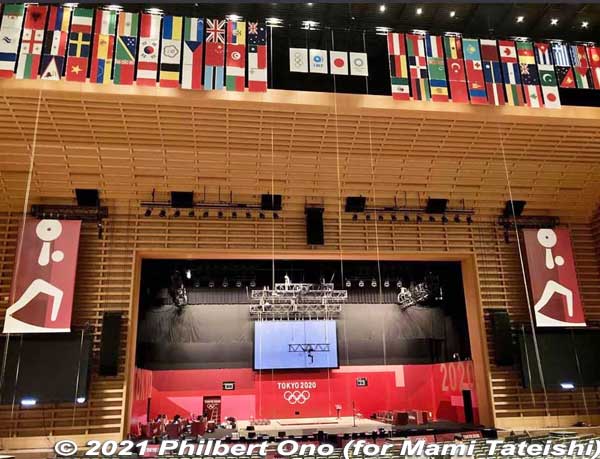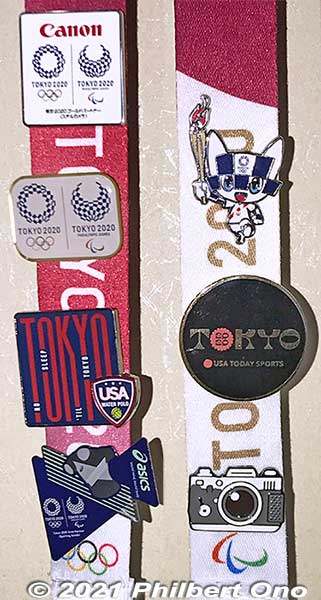Comprehensive chronology of the Tokyo 2020 Olympics from July to Aug. 2021 plus photos of all Tokyo 2020 venues during the Games. No spectators were allowed at competitions. Only team members, coaches, staff, press members, and volunteers were allowed in.
Updated: Dec. 5, 2023
Compiled and written by Philbert Ono (former TOCOG employee). Preserving Tokyo 2020 history, images, and memories.
Tokyo 2020 Olympics: July 23–August 8, 2021
July 21, 2021: Tokyo 2020 Olympic competition starts with women’s softball and football.
Tokyo 2020 Olympics Opening Ceremony
🔴 July 23, 2021: Tokyo 2020 Olympics Opening Ceremony is held at the Olympic Stadium with 6,000 athletes and no spectators. The NHK television audience for the live broadcast of the Olympics Opening Ceremony averaged 56.4 percent of viewers in the Tokyo area. https://olympics.com/en/news/top-moments-from-the-opening-ceremony-of-the-olympic-games-tokyo-2020
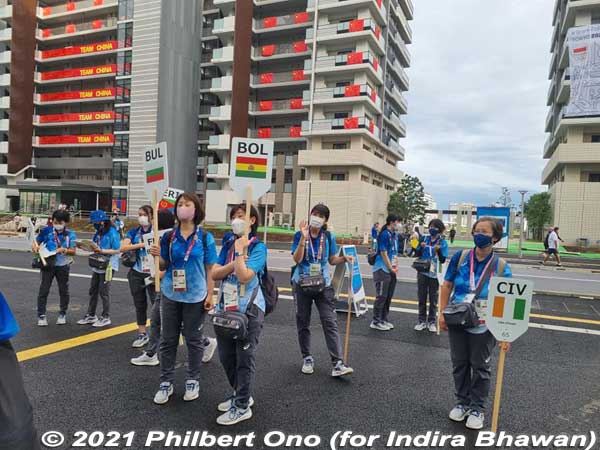
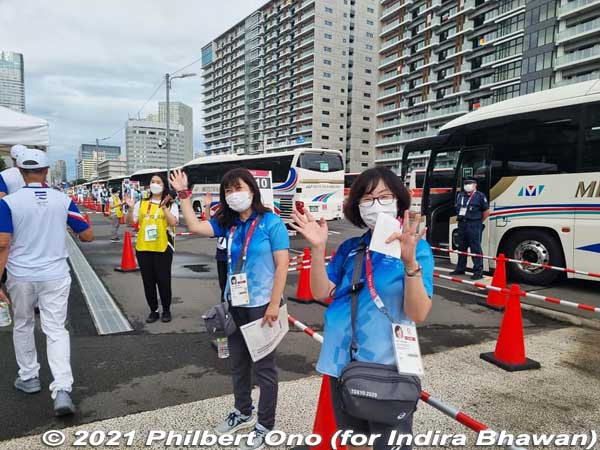
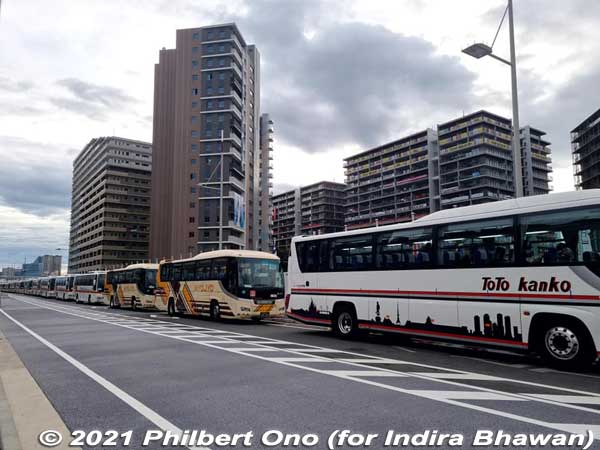


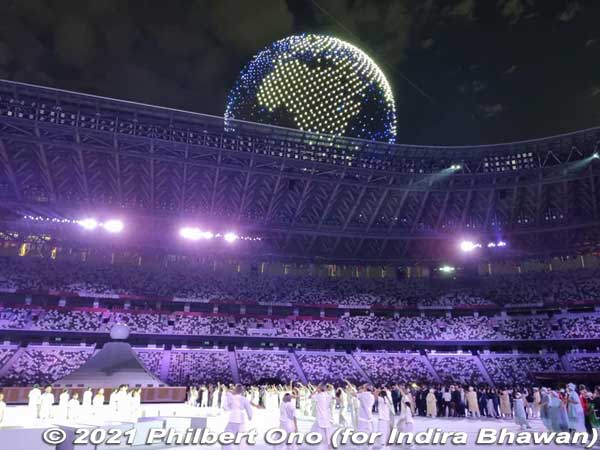
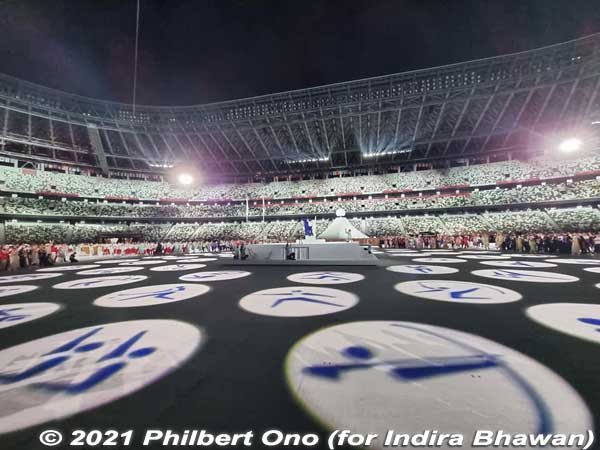

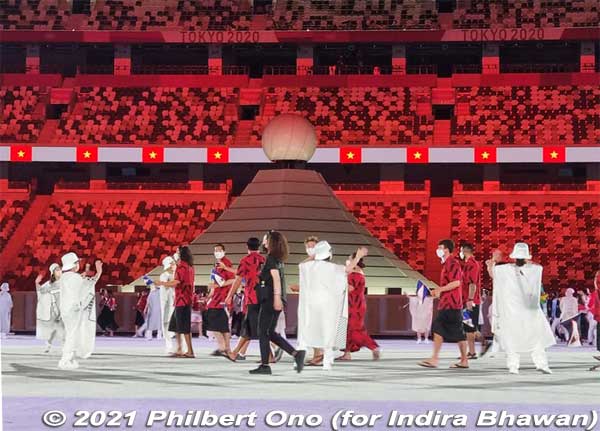
A: At the Olympic Village, volunteers hold signs (Bulgaria, Bolivia, and Ivory Coast) to direct athletes to their buses for the Opening Ceremony.
B: At the Olympic Village, volunteers wave to the Cabo Verde delegation going to the Opening Ceremony.
C: At the Olympic Village, a long line of buses await athletes going to the Opening Ceremony.
D: At the Olympic Stadium, athletes line up to enter the field for the Opening Ceremony. (Guyana is pictured.)
E: Inside the Olympic Stadium during the Opening Ceremony.
F: Globe aerial sculpture created with drones.
G: Live pictogram show on the small stage.
H: Fireworks were not part of cost-cutting measures. Also delighted the crowd watching outside the stadium. (Tokyo Governor Koike did say the Games should not be dull.)
I: Olympic flame cauldron (before lighting by Naomi Osaka).
🔴 July 23–August 9, 2021: Tokyo 2020 Olympics is held with 11,259 athletes from 206 NOCs (including a refugee team). They compete in a record number of 33 sports and 339 events held at 42 venues. Includes five new Olympic sports: baseball/softball, karate, skateboarding, surfing, and sports climbing. A major theme is urban sports such as skateboarding and BMX freestyle geared for the younger generation. For gender equality at Tokyo 2020, a record 48 percent of Olympic athletes are female.
During the Tokyo 2020 Olympics, new world records are set in 20 events in six sports.
The number of Tokyo Olympics participants from overseas is reduced to one-third the original number, from 141,000 to 33,000 people.
Breakdown:
Olympic Family: 1,000
NOC (National Olympic Committees, including athletes): 11,400 (Final count 11,259)
IFs (International sports federations): 2,600
OBS (Olympic Broadcasting Services): 11,000
Press: 3,200
Others: 3,700
Approx. total from overseas: 33,000
As Japan wins a record number of Olympic medals, the Japanese public comes around and heavily favors the holding of the Olympics.
🍀Total 51,672 Field Cast volunteers work during the Olympics. (Also, 24,514 Games volunteers work during the Paralympics.) Volunteers originally assigned to Event Services (EVS) to take care of spectators have problems finding alternate roles. Some, especially those who are bilingual, are reassigned to other roles. Others have hardly any days to be a volunteer.
Japan’s summer heat and humidity prompts schedule changes in tennis, the women’s soccer final, and the women’s marathon.
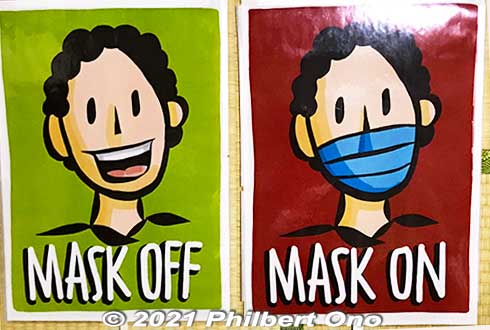
The IOC allows medalists to remove their masks for 30 seconds to pose for photos while on the podium. They are signaled with “Mask Off/On” signs held by Press Operations staff/volunteers.
🍀Athletes and staff/volunteers working near athletes are tested daily for Covid. Other volunteers and staff are tested at least every four or seven days for Covid with saliva samples.
Led by ALSOK, 553 security companies from all 47 prefectures provide the 14,000 security staff required daily during Tokyo 2020. Total security staff employed is 517,000. They are allowed to carry drinks (first time at an Olympics), and none are stricken with a serious case of heat illness.
July 23, 2021 onward: Long lines form in front of the Olympic rings in front of the Japan Olympic Museum (near the Olympic Stadium). People (families) want to take selfies with the rings. It takes as long as an hour wait.
🍀July 24, 2021: TBS TV reports that due to no spectators, fewer volunteers were assigned to the Opening Ceremony, resulting in over 4,000 extra bento meals (40 percent) for volunteers discarded as food waste.
For July 2021, 810,000 bento (box lunches) were provided, but 190,000 bento (24%) were discarded. In August, out of 690,000 bento, 100,000 (15%) was discarded. In September, out of 100,000 bento, 8,000 (8%) were discarded.
The food waste was reduced as the weeks passed. Excess rolls were donated to food banks and the discarded meals were made into fertilizer or biogas.
One common silent complaint among volunteers and staff at many venues was that the free meals were not so delicious (too salty) and the menu not diverse. This also contributed to food waste. (Only the desserts were all consumed.) Only some of the venues had good food.
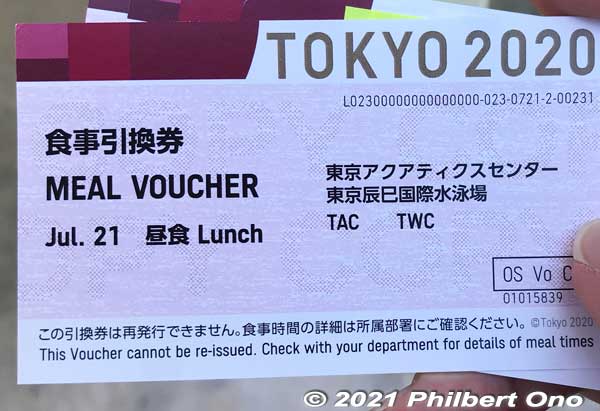
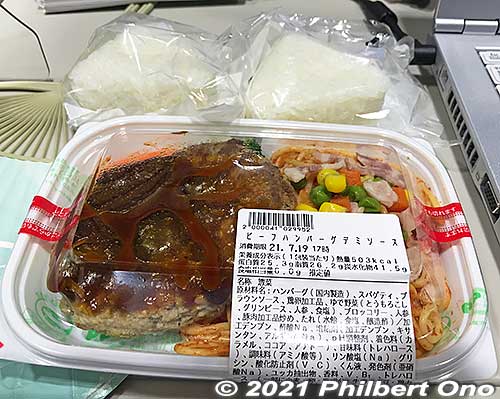

A: Daily meal voucher is required to get your meal. Available at the volunteers’ check-in desk.
B: Free lunch for volunteers and staff. At many venues, the bento meals looked like this and were not very good (too salty). Minimal menu variation. Spaghetti and rice balls or rolls every day. No halal nor vegetarian food.
Significant number of volunteers and staff declined to eat the food, increasing the amount of food waste that made news headlines.
C: Only the free ice cream (and drinks) and occasional dessert like cheesecake were totally consumed. The small cup of ice cream (left) always disappeared quickly. The stick ice cream (right) was not bad, but not as popular as the cup. Certain venues like the rowing venue, Olympic Village, and MPC did serve good food.
July 26, 2021: Team Israel’s baseball pitcher Ben Wanger posts a viral TikTok video showing how many athletes are needed to destroy the cardboard bed in the Olympic Village. His experiment concludes that nine Israeli Olympians jumping on the bed together can break the cardboard bed. Since the bed can support up to 200 kg, the nine athletes supposedly weigh more than 200 kg total.
Wanger soon deletes the video (still online at kann_news) and he and all the athletes involved apologize. At the end of the Games, Village volunteers/staff find more cardboard beds purposely damaged by athletes from other countries.
July 27, 2021: At Ariake Gymnastics Centre, US gymnast Simone Biles withdraws from the gymnastics final, citing the immense mental pressure. She is widely hailed for her courage and decision.
July 29, 2021: On a JAL flight home from Tokyo to Sydney, most of Australia’s Olympic rugby sevens and soccer players got terribly drunk and unruly on the 10-hour flight. At least one drunken football player vomited in one of the plane’s toilets, rendering it unusable for the rest of the flight. They were loud and disruptive to other passengers, drank in the aisles, did not wear masks, and did not follow directions from flight staff. Forty-nine Australian Olympians from nine sports were on the flight.
Some Olympic Village rooms occupied by Australian Olympians (rugby players and rowers) were also trashed, cardboard beds destroyed, and even rooms with a hole punched in the wall. The incident was reported on the news on Aug. 4, 2021, and Australia’s Olympic team chef de mission Ian Chesterman vowed to find out who did what and take disciplinary action. Being the first national team (“Aussie Spirit” women’s softball team) to arrive in Japan for the Games, Australia initially made a great impression on Japan but left with a shameful image.
July 31, 2021: TOCOG announces that two judoka from Georgia, silver medalists Vazha Margvelashvili and Lasha Shavdatuashvili, have been ejected from the Olympics for going sightseeing. The Georgians were seen in their Georgian uniforms near Tokyo Tower on the evening of July 27. COVID-19 rules state that athletes can only travel from their accommodations to competition venues or other permitted destinations. They are not allowed to take public transportation and walk around in the city, go shopping, etc.
Tokyo 2020 Venues
Go to (mostly alphabetical order):
Olympic Village | Aomi Urban Sports Park | Ariake Arena | Ariake Gymnastics Centre |
Ariake Tennis Park | Ariake Urban Sports Park | Asaka Shooting Range | Canoe Slalom Centre |
Enoshima Yacht Harbour | Equestrian Park | Fuji International Speedway |
Fukushima Azuma Baseball Stadium | Ibaraki Kashima Stadium | International Stadium Yokohama | Izu MTB Course | Izu Velodrome | Kasumigaseki Country Club |
Kokugikan Arena | Makuhari Messe | Miyagi Stadium | Musashino Forest Sport Plaza |
Musashinonomori Park | Nippon Budokan | Odaiba Marine Park | Oi Hockey Stadium |
Olympic Stadium | Saitama Stadium | Saitama Super Arena | Sapporo Dome |
Sapporo Odori Park | Sea Forest Cross-Country Course | Sea Forest Waterway |
Shiokaze Park | Tatsumi Water Polo Centre | Tokyo Aquatics Centre |
Tokyo International Forum | Tokyo Metropolitan Gymnasium | Tokyo Stadium |
Tsurigasaki Surfing Beach | Yokohama Baseball Stadium | Yoyogi National Stadium |
Yumenoshima Park Archery Field | Tokyo Big Sight (Press Centre)
Photo: In the foreground is Sea Forest Waterway and Cross-Country Course (yellow). Odaiba and Rainbow Bridge on the upper left. Olympic Village at center top. Aquatics venues on the upper right corner. Tokyo Big Sight and Ariake venues toward the middle. Blue labels are train stations.
Olympic Village (OLV Harumi 選手村)
The Olympic/Paralympic Village had 21 buildings (14 to 18 floors each) to provide 3,850 apartment units with 18,000 beds for Olympic athletes and staff and 8,000 beds for Paralympic athletes and staff. There also were the Main Dining Hall, a three-story multi-function complex, and the woody Village Plaza with a beauty salon, gym, medical clinic, gift shop, etc., for athletes. Excluding the two waterfront parks, the Olympic Village was about 650 meters long and 350 meters wide, occupying the best one-third of the Harumi area (island).
After the Games, the Olympic Village will be renovated into condominiums for sale and rent and renamed “Harumi Flag.” Two 50-story towers will also be constructed (taking three years) to add 1,455 condominium units for sale. Since Olympic regulations do not allow high-rise buildings in Olympic Villages, the towers will be constructed after the Games.
The Main Dining Hall site become an elementary and junior high school, and the three-story multi-function complex will become a shopping mall. Condo owners were supposed to start moving in from March 2023, but this has been delayed by at least a year due to the postponement of Tokyo 2020. Harumi Flag will eventually house 12,000 residents from 2024. Since the current population of Harumi is about 16,000, the complex will greatly increase the local population.

L-R: USA, Australia, Italy, Finland and Sweden, and Thank you banner.

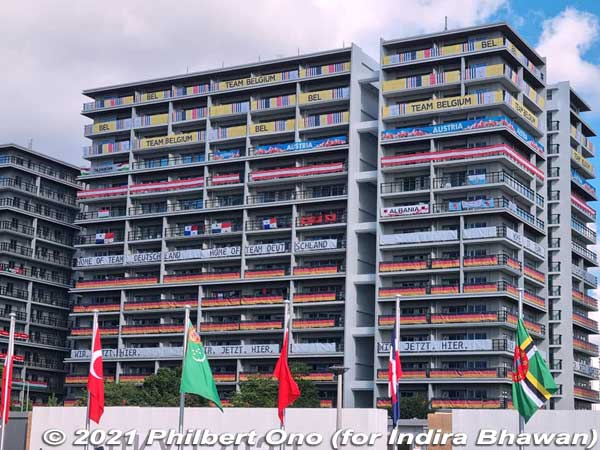
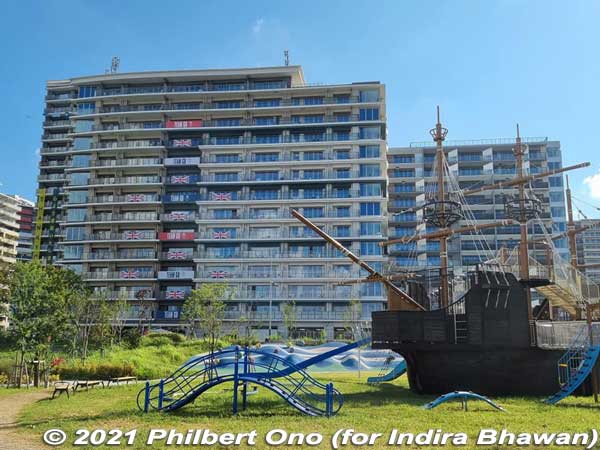
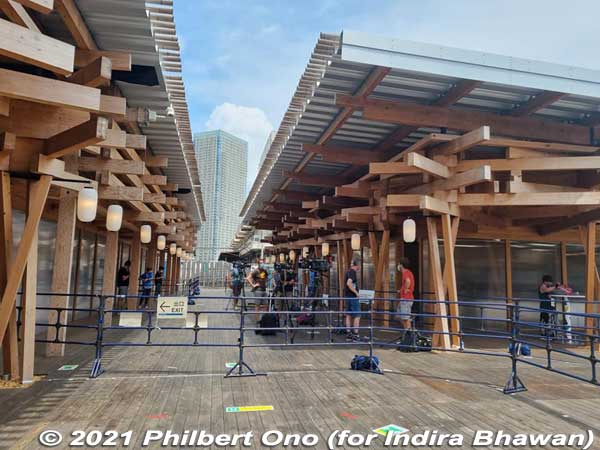

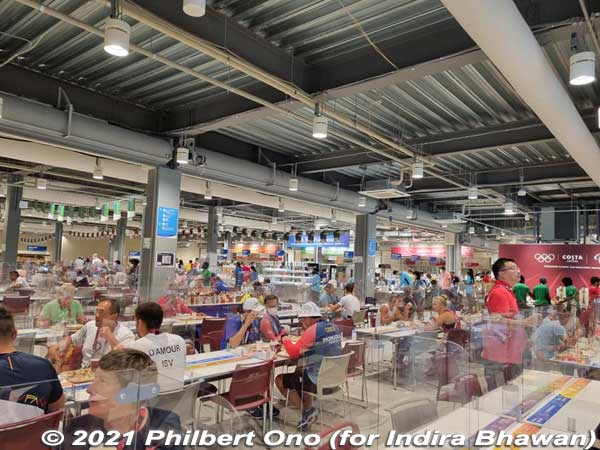
A: Flags Street, a main street.
B: Quarters for Belgium, Austria, Germany, and Albania.
C: Waterfront park popular to watch sunsets.
D: Athletes’ Village Plaza serves only Village residents. It houses the official Tokyo 2020 shop, post office, barber shop, general store, custom shoe store (ASICS), and other essential services. The building was made of wood donated from all 47 prefectures (63 municipalities) of Japan. The wood was branded with their place of origin. After the Games, the building was disassembled and wood shipped back to their prefectures for reuse.
E: Athletes’Village Plaza PSA (Pedestrian Screening Area) where they screen your bags and accreditation card.
F: Main Dining Hall can serve a maximum 45,000 meals per day. Tables have plexiglass on the tables and sanitizing wipes. The seating was reduced for social distancing.
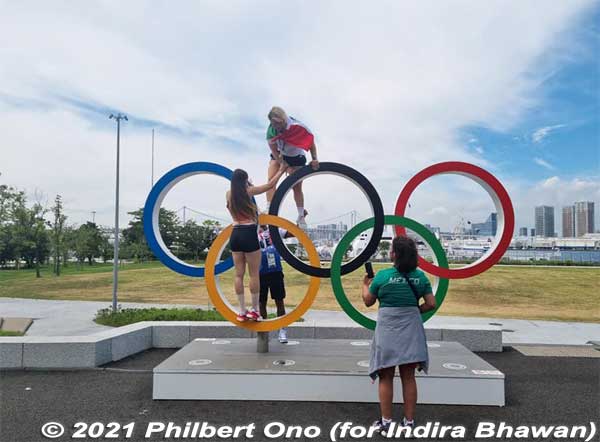
Problems at Olympic Village included groups of athletes drinking and partying loudly in the waterfront park (Harumi Futo Park) or near the residential buildings. Security patrols to break up noisy gatherings were beefed up, and notices about the problem were issued to all the national teams.


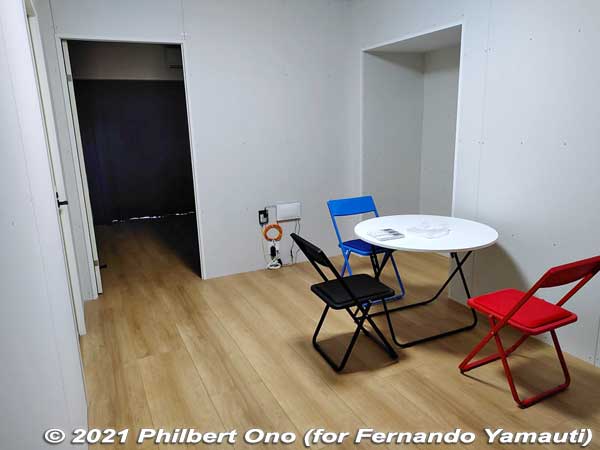
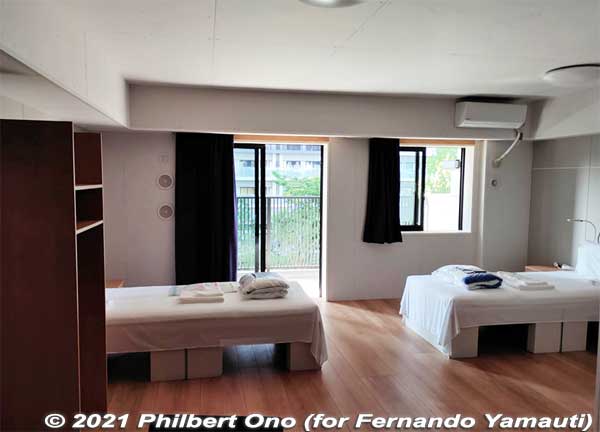

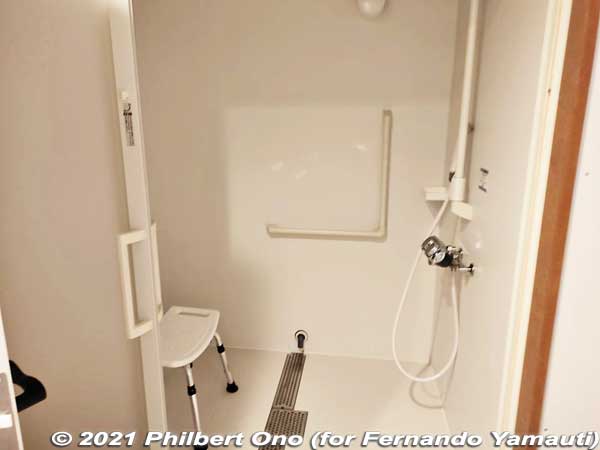
G: Flags Street with Italy and Argentina housed in the background building.
H: Sample furnished room.
I: Actual living room for athletes.
J: Bedroom for two athletes.
K: Beds are made of 100% recyclable cardboard.
L: Bathroom/shower.
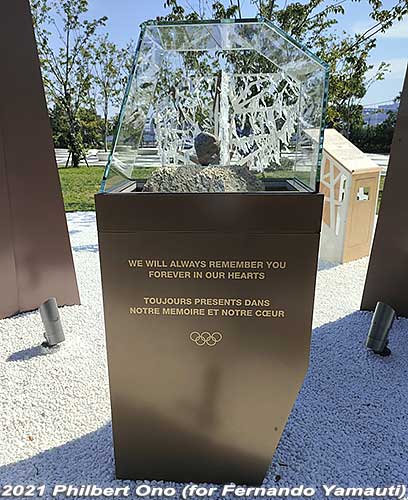
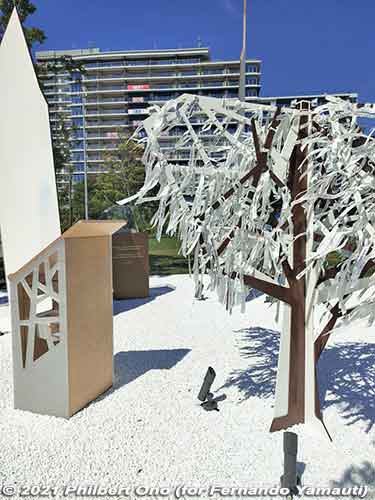
At the Olympic Village, the Place of Mourning and Remembrance Tree at the end of Flags Street memorialize the eleven Israeli athletes killed by Palestinian terrorist gunmen at the 1972 Munich Summer Olympics on September 5, 1972. This memorial, first displayed at the Rio athletes’ village, travels to each Olympics.
At Tokyo 2020, for the first time at an Olympic Opening Ceremony, a much belated moment of silence was observed for the victims.
Tokyo 2020 Competition Venues (Alphabetical Order)
Look of the Games at Tokyo 2020 Olympic and Paralympic venues came in one of the five traditional Japanese colors (not Olympic colors) of Kurenai red, Ai indigo blue, Sakura cherry blossom pink, Fuji wisteria purple, and Matsuba pine green. All beautiful. Each venue has a three-letter abbreviation used mainly among Games’ staff.
Besides the competition venues, there were 80 Olympic training facilities and 27 Paralympic training facilities which opened five days before the start of the respective competition.
No smoking at all venues, both indoors or outdoors. No rooms or spaces for smoking were provided. This resulted in a few violations of people smoking at venues.
*If you want to contribute photos of venues, contact us.
*Special thanks to Games volunteer and staff friends who contributed photos.
Aomi Urban Sports Park (AUP) (青海アーバンスポーツパーク) – Sport Climbing, 3×3 Basketball, Football 5-a-side
・Opened: March 2020 ・Location: Near Tokyo Teleport Station. ・Map ・Status: Temporary venue, demolished.
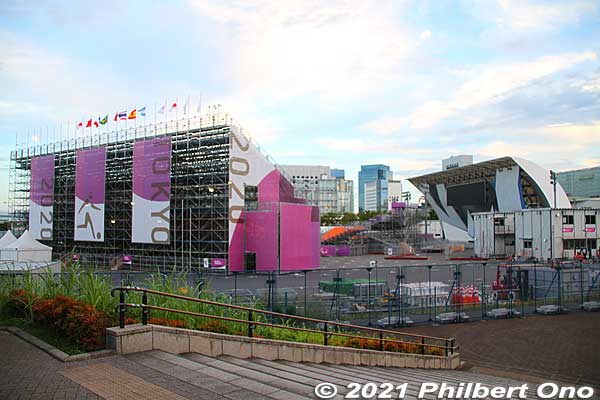
Aomi Urban Sports Park was a temporary venue built on a large parking lot near two big shopping malls in Odaiba, Diver City (Gundam statue) and Venus Fort.
The sports climbing wall was already built and tested in March 2020. Upon the postponement of the Games, the sports climbing wall was partially dismantled for safety reasons. Only the wall’s support structure remained. The spectator stands were also removed since they were not durable outdoors for a year.
Ariake Arena (ARA) (有明アリーナ) – Volleyball, Wheelchair Basketball
・Opened: Feb. 2020 ・Location: Near Ariake-Tennis-no-Mori and Shin-Toyosu Stations. ・Map ・Status: To open for public events.
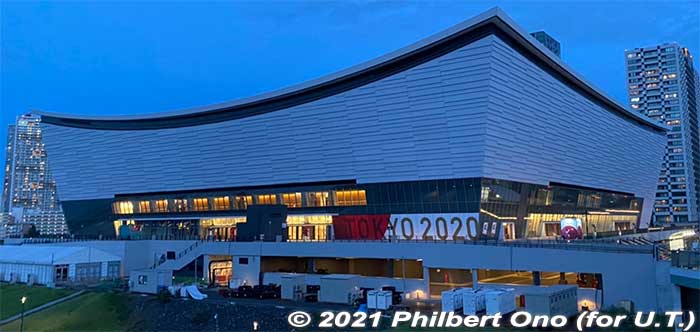
Completed in December 2019 and dedicated on February 2, 2020. New, permanent venue made with the walls and ceiling made of lots of wood from western Tokyo’s Tama district. It reflects the Kiba area being Tokyo’s traditional lumberyard. After the Games, it will become a multi-purpose venue for concerts and events and it is expected to operate in the black.
To reach the arena, there are also buses from Tokyo Station Marunouchi South Exit (bound for Tokyo Big Sight) and from Monzen-Nakacho Station (Tozai subway line) bound for Tokyo Teleport station, get off at Ariake Shochu Gakko-mae bus stop. It’s also walkable from Shin-Toyosu Station (Yurikamome Line).
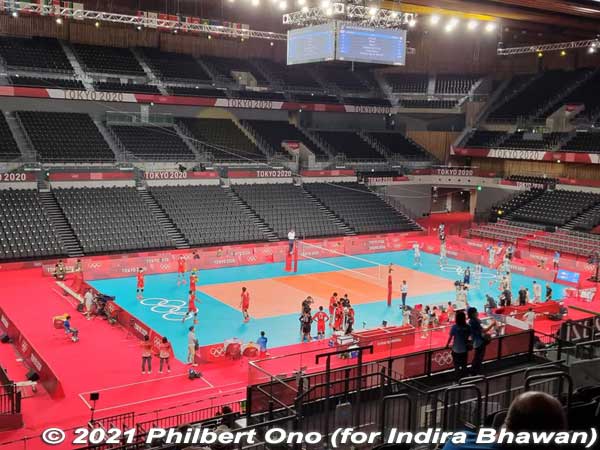


Ariake Arena‘s Look of the Games was Kurenai Red. Photos above show a women’s volleyball match between Brazil (silver medal) and USA (gold medal). (Click/tap on thumbnail image to enlarge.)
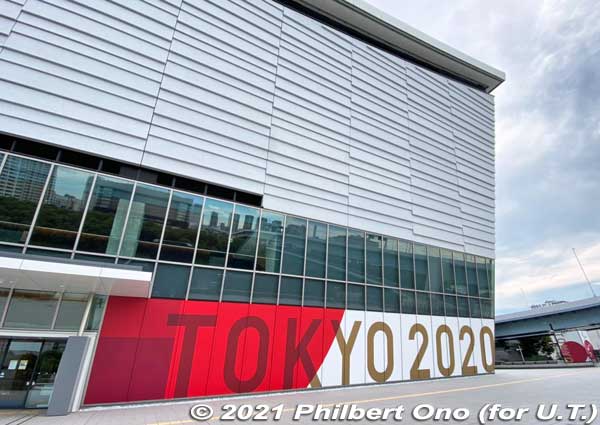
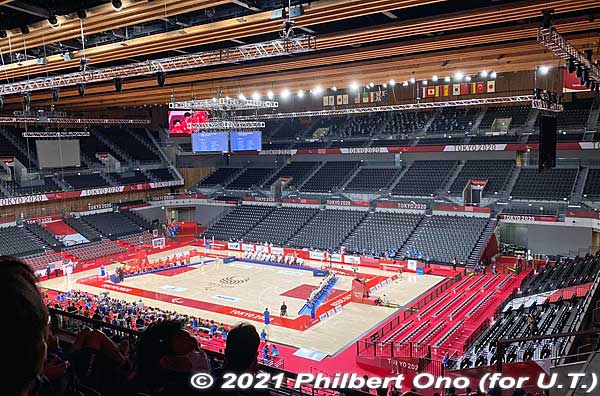
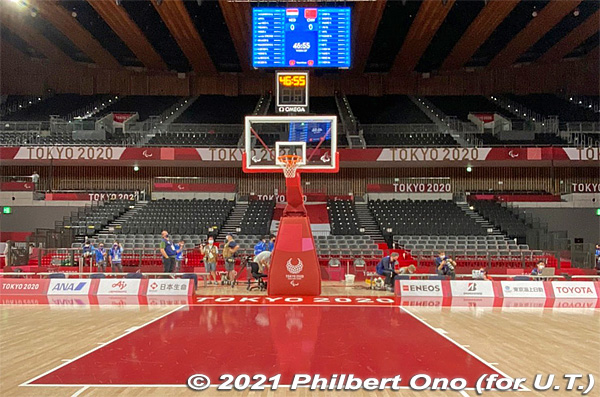
Ariake Gymnastics Centre (AGC) (有明体操競技場) – Gymnastics, Boccia
・Opened: Oct. 2019 ・Location: Near Ariake-Tennis-no-Mori Station. ・Map ・Status: Temporary venue, retained for other purposes (exhibition hall).
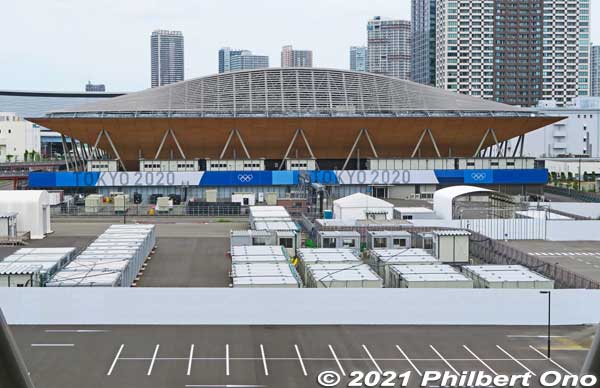
Swank-looking, wooden building, highly visible from Ariake-Tennis-no-Mori Station. Tokyo 2020’s largest venue made of wood (karamatsu Japanese larch, cryptomeria, etc.). Capacity was 12,000 including 135 wheelchair spaces. The building won the BCS Award (Building Contractors Society BCS賞) for outstanding architecture by the Japan Federation of Construction Contractors (日本建設業連合会).
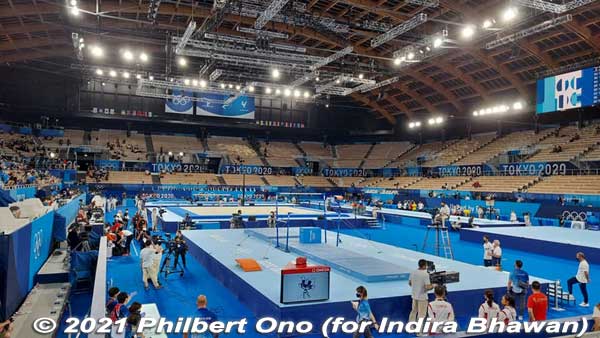
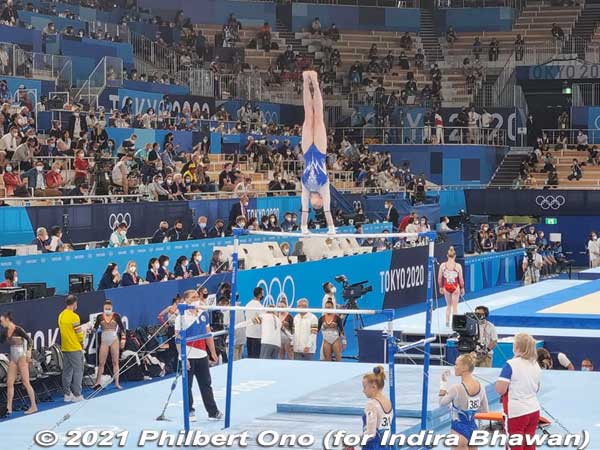
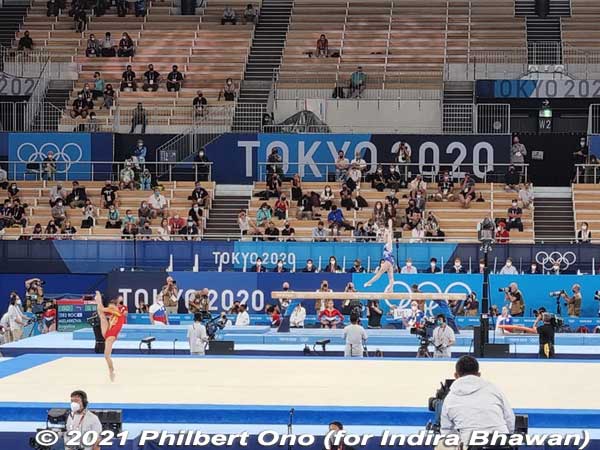
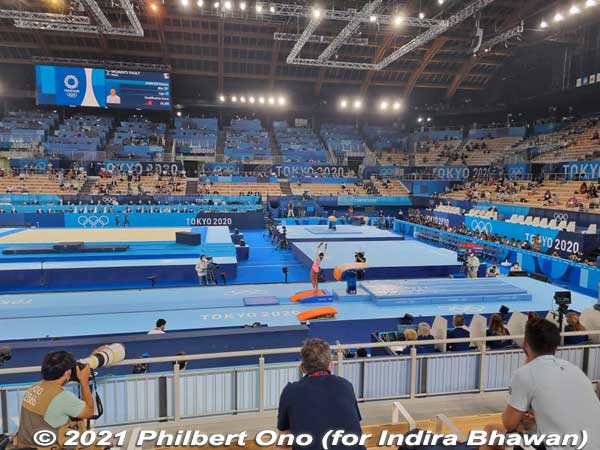
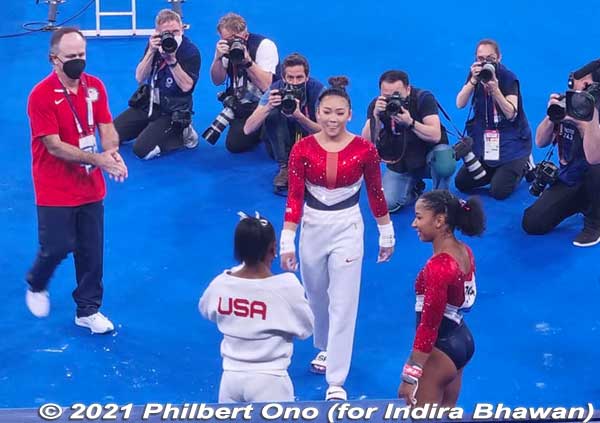
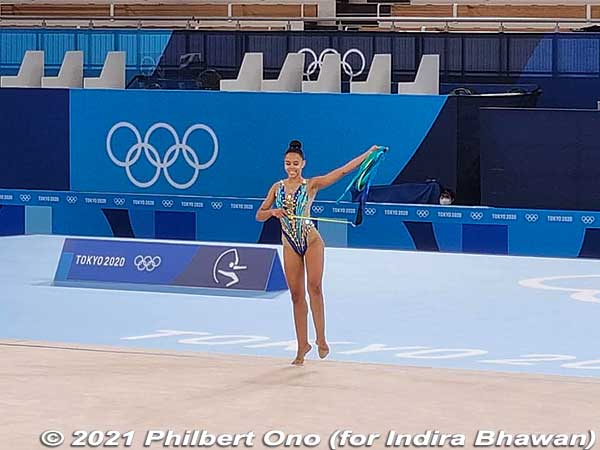
A: Artistic gymnastics at Tokyo 2020.
B: Russian Olympic Committee (ROC) gymnast on uneven bars.
C: Floor exercise and balance beam.
D: Vault.
E: USA gymnasts Sunisa Lee and Simone Biles (in white) exchange a few words.
F: Cabo Verde rhythmic gymnast Marcia Alves Lopes competes.
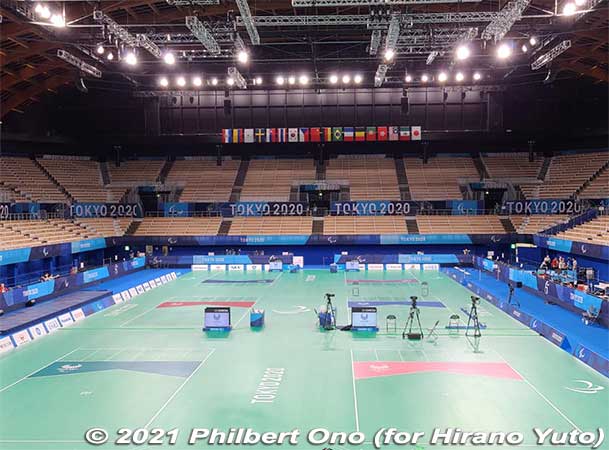
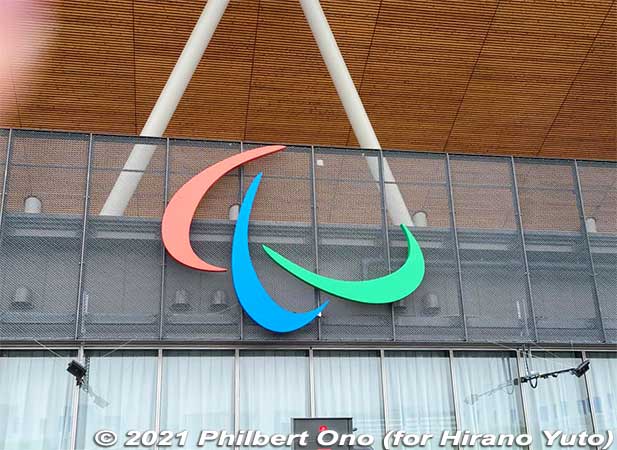
Ariake Tennis Park (ART) (有明テニスの森) – Tennis, Paralympic Tennis
・Opened: May 1983 ・Location: Near Kokusai-tenjijo, Ariake, and Ariake-Tennis-no-Mori Stations. ・Map ・Status: After completing major renovations, Coliseum, Show Court, and indoor courts to reopen in March 2022. Outdoor courts to reopen in March 2023.
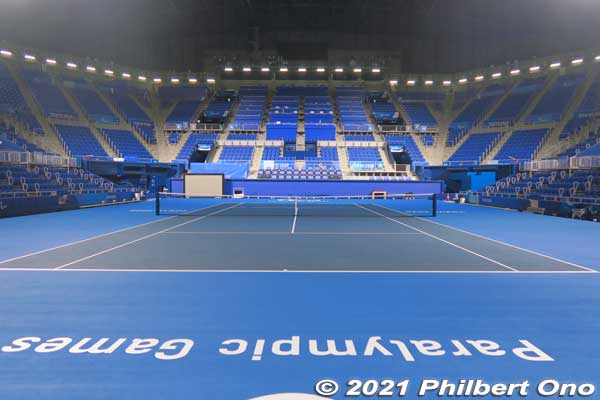
Huge spread of tennis courts anchored by Ariake Coliseum (Centre Court) which opened in 1987, four years after the tennis park opened on a former golf course. Two new Show Courts built for Tokyo 2020.
Ariake Coliseum (有明コロシアム) has a moving roof to make it an open-air or indoor court. Besides tennis, the Coliseum is used for concerts, pro wrestling, and pro basketball.
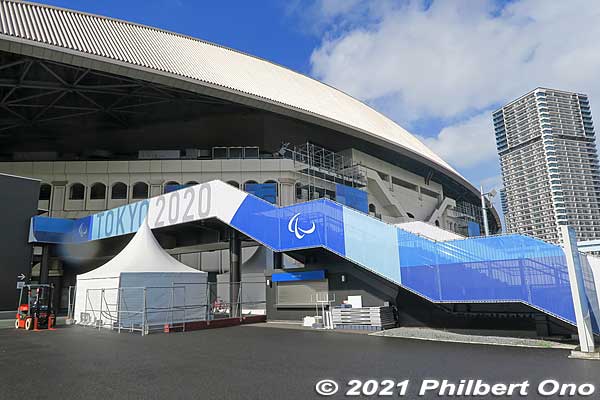
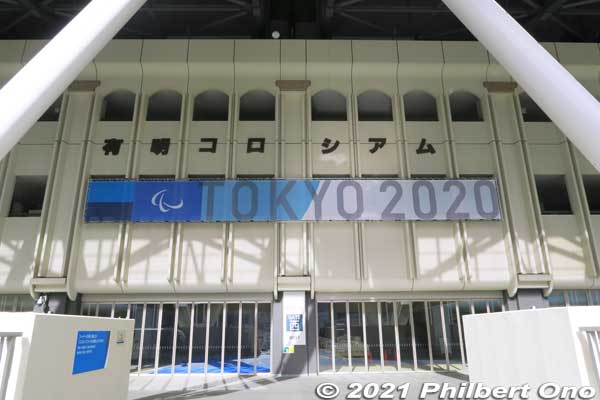
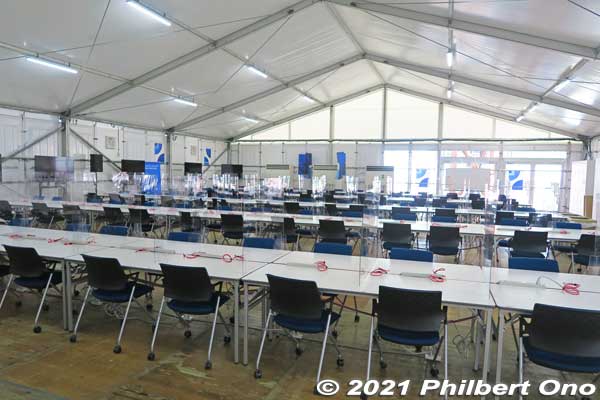
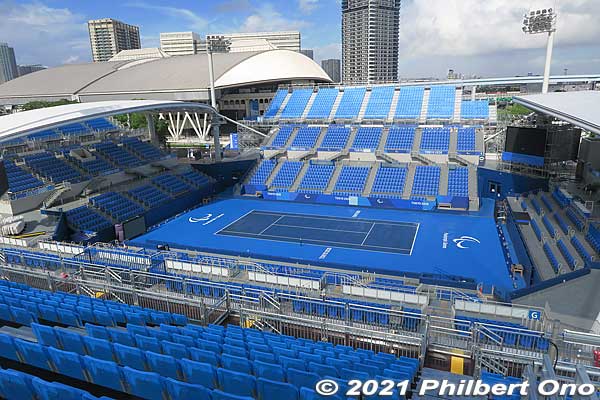

Ariake Tennis Park (ART) has the main Centre Court in Ariake Coliseum and Show Courts No. 1 and No. 2 with spectator stands. It also has Show Courts No. 3 to 11 with almost no spectator seating. Photos show the Paralympic Look of the Games (wheelchair tennis).
A: Look of the Games in indigo on the stairs outside Ariake Coliseum.
B: Ariake Coliseum exterior.
C: Inside Venue Media Centre next to Ariake Coliseum. Press Conference Room was also inside this temporary building.
D: Show Court No. 1.
E: Show Court No. 2.
(Special thanks to Asuka-san for the tour.)
Ariake Urban Sports Park (ASP) (有明アーバンスポーツパーク) – Skateboarding, BMX Racing, BMX Freestyle
・Opened: 2020 ・Location: Near Ariake-Tennis-no-Mori Station. ・Map・Status: Temporary venue, demolished.
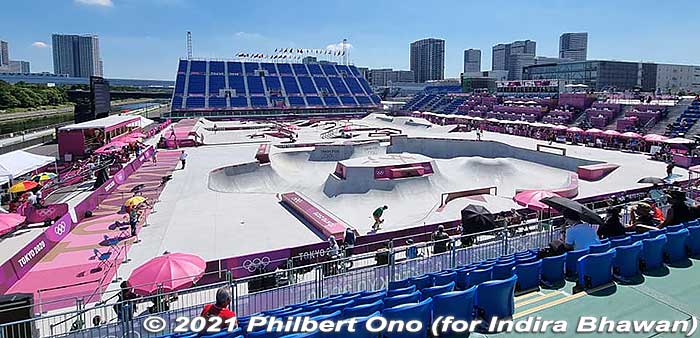
Cluster of three venues for BMX racing, freestyle BMX, and skateboarding. The site was originally planned for building a cycling velodrome and MTB course before both were moved to Izu Peninsula to save venue costs. The skateboarding venue was originally planned for Aomi Urban Sports Park until it was changed to Ariake Urban Sports Park in Dec. 2017.

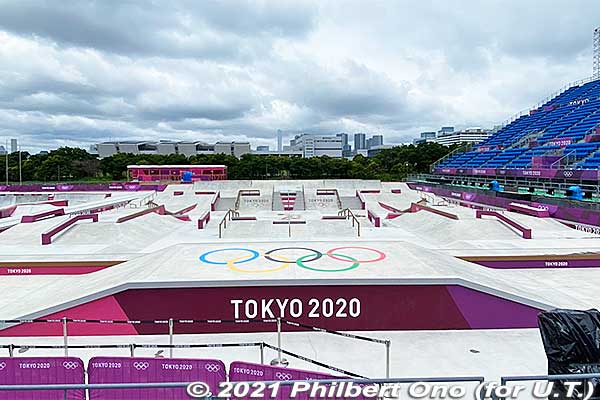

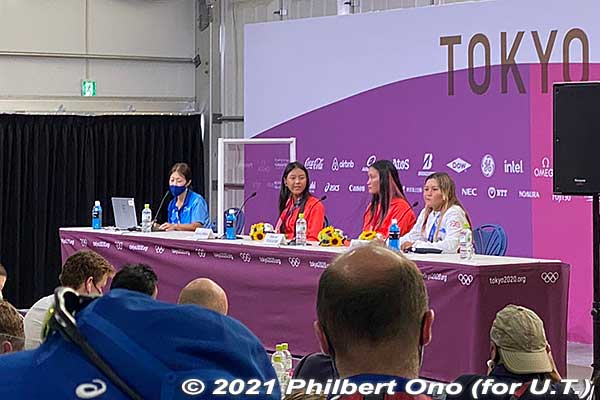
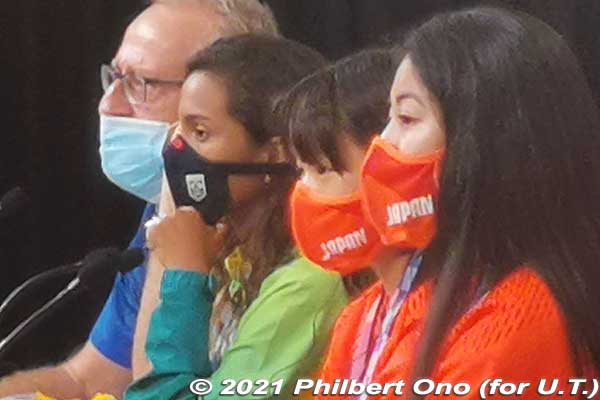

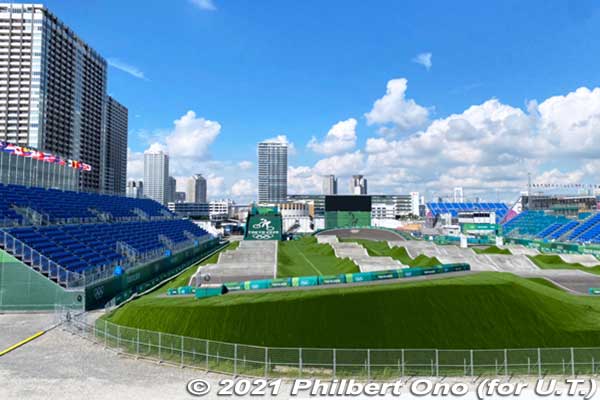
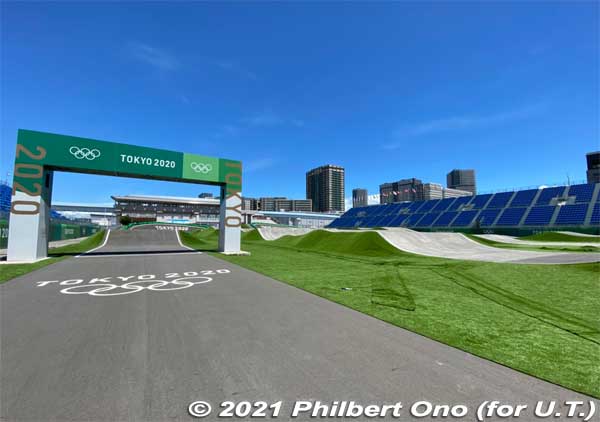
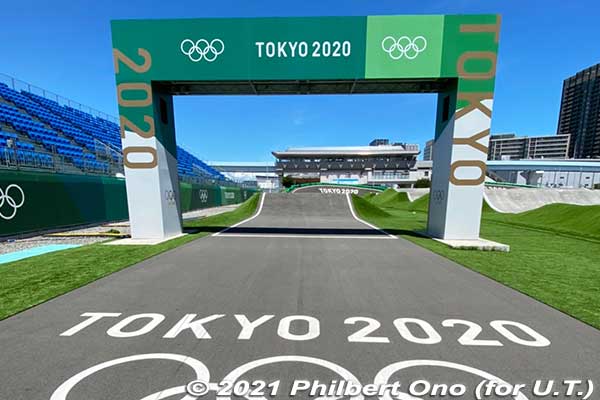
A: Park skateboarding venue.
B: Street skateboarding venue behind the park venue.
C: BMX Freestyle cycling venue.
D: Women’s park skateboarding medalists at a press conference. L-R: HIRAKI Kokona (silver), YOSOZUMI Sakura (gold), and Sky BROWN (bronze) on August 4, 2021.
E: Women’s street skateboarding medalists at a press conference. L-R: LEAL Rayssa (silver), NISHIYA Momiji (gold), and NAKAYAMA Funa (bronze)
F: Men’s street skateboarding gold medalist HORIGOME Yuto, a local boy from Koto Ward where the venue is located.
G: BMX Racing course.
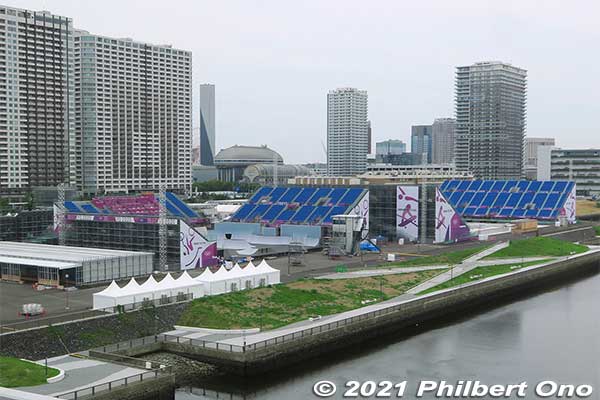
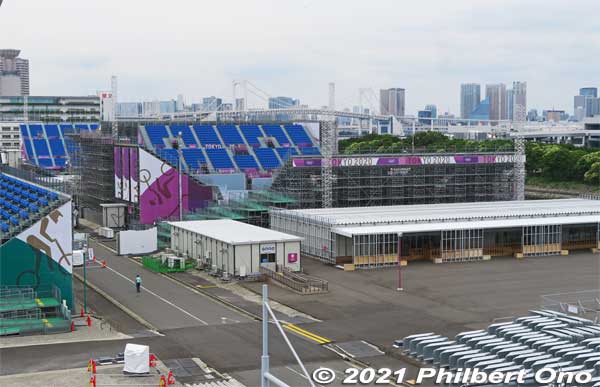
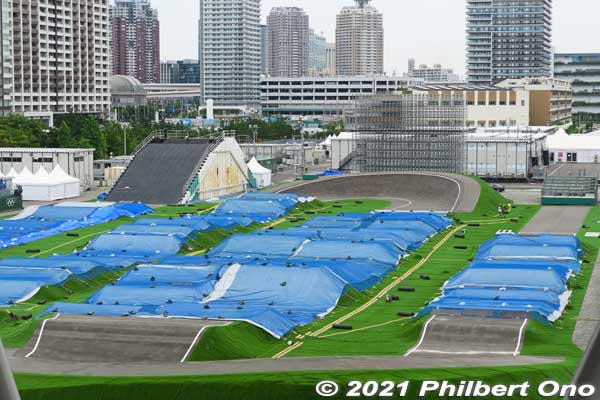
H: The large venue site (reclaimed land) was originally proposed for the Olympic Village.
I: BMX freestyle venue and spectator entry gate that was never used.
J: BMX racing track is covered with tarps before the Games. Since Ariake Urban Sports Park was visible from Ariake-Tennis-no-mori Station, station windows were covered up during the Games.
Asaka Shooting Range (ASR) (陸上自衛隊朝霞訓練場) – Olympic/Paralympic Shooting
・Opened: 1964 ・Location: Near Asaka and Wakoshi Stations (bus). ・Map・Status: Temporary faciilties dismantled. Closed to the public, being a Japan Ground Self-Defense Force base. Only the PR museum (Japan Ground Self Defense Force Public Information Center) is normally open to the public (currently closed due to the pandemic).
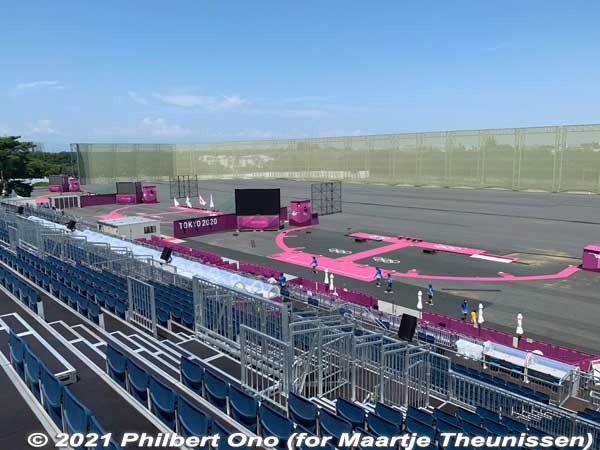
Legacy venue since it was used for rifle shooting events during the 1964 Tokyo Olympics. Normally used by the Japan Rifle Shooting Association and JSDF Physical Training School.

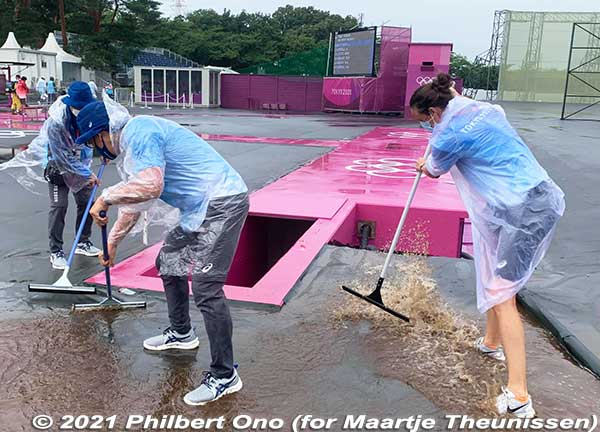
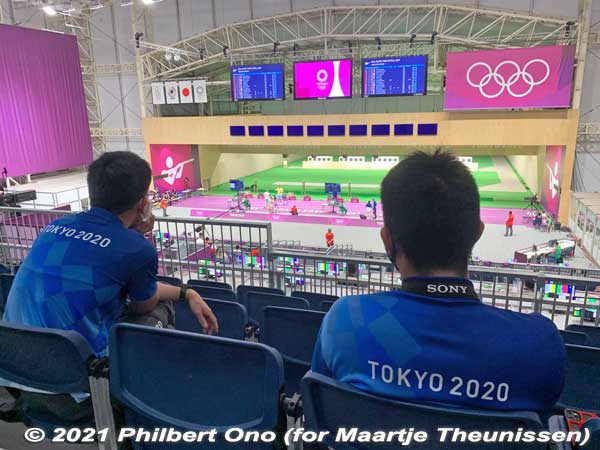
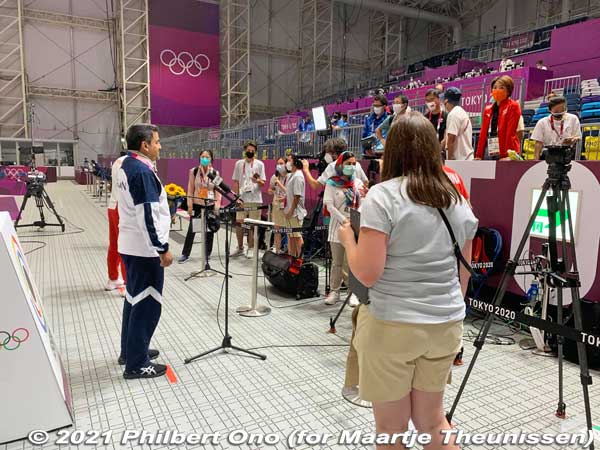
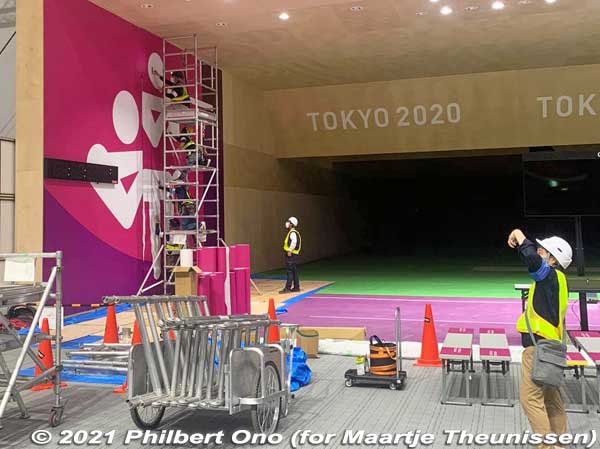
Asaka Shooting Range had three shooting ranges: Shotgun Range (Ranges A to C), Qualification Hall (Rifle & Pistol), and Finals Hall (Rifle & Pistol). Olympic Shooting photos above. (Photos by Maartje Theunissen)
A: Photographers at skeet shooting at the Shotgun Range.
B: Shotgun Range with volunteers/staff dealing with rainy days.
C: Finals Hall (Rifle & Pistol) from spectator seats.
D: Broadcast Mixed Zone in Finals Hall.
E: Transitioning from Olympics to Paralympics with a new shooting pictogram in the Finals Hall.
Paralympic Shooting
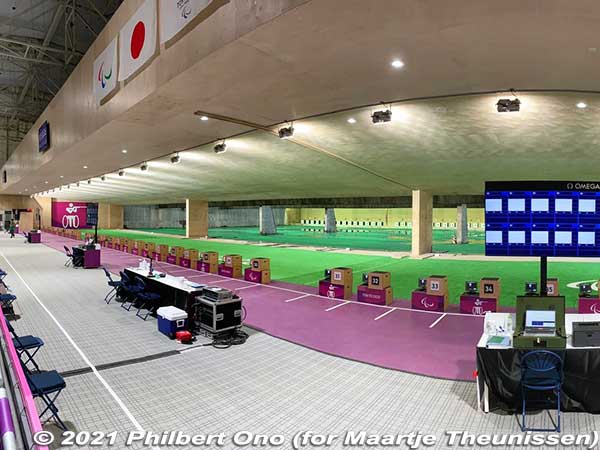
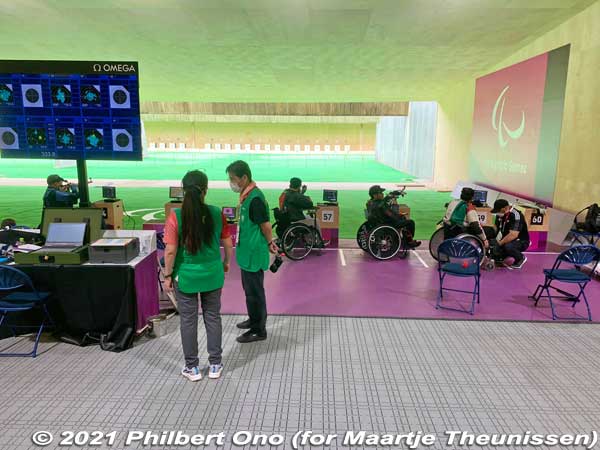
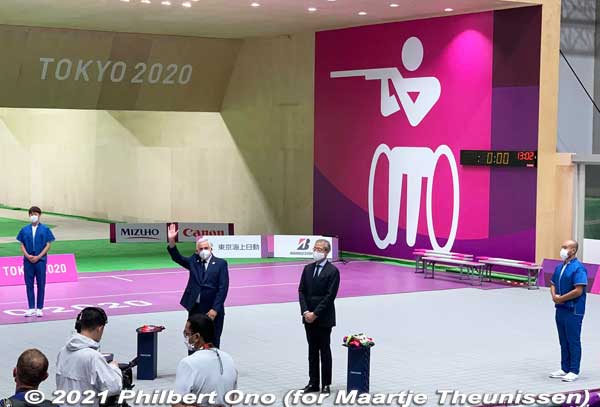
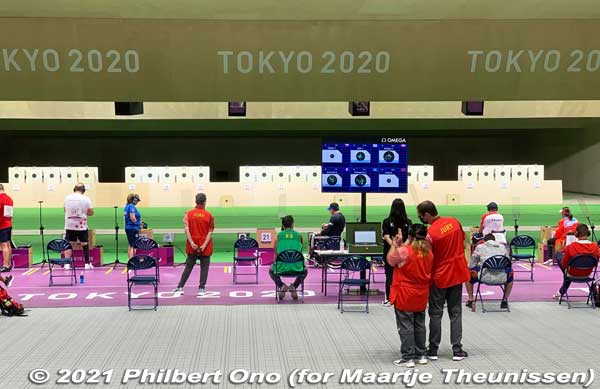
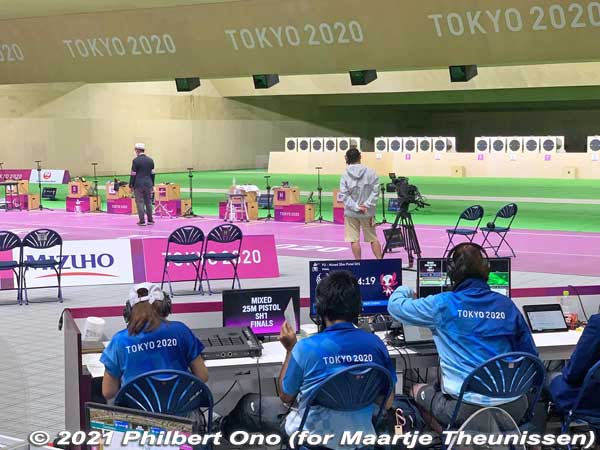

G: Qualification Hall (Rifle & Pistol).
H: Paralympic Rifle Qualification in the Qualification Hall.
I: Paralympic medals ceremony in Finals Hall.
J: Pistol Paralympic Qualification in Finals Hall.
K: Pistol Paralympic Finals.
L: OBS (Olympic Broadcasting Services) truck.
Canoe Slalom Centre (KSC) (カヌー・スラロームセンター) – Canoe (Slalom)


Enoshima Yacht Harbor (EYH) (江の島ヨットハーバー) – Sailing
・Opened: 1964 ・Location: Near Katase-Enoshima Station. ・Map ・Status: Open to the public.
Owned by Kanagawa Prefecture, Enoshima Yacht Harbor is a legacy venue used in the 1964 Tokyo Olympics for yachting (that’s what sailing was called back then). The small Olympic flame cauldron used in 1964 still stands at the harbor. The harbor is very popular among private boat owners because of its proximity to Tokyo and the area being a major tourist attraction.
Enoshima island is a major tourist attraction with the shopping path to the Shinto shrine and walking paths in and around most of the island for scenic views. Nearby Kamakura is also a major tourist attraction with the giant Daibutsu Buddha, Buddhist temples, and shrines.
To make room for the Tokyo Olympics, the 700 sailing dinghies and other boats in the harbor had to be moved out. From Jan. 2020, they started moving the boats to 17 locations in and outside the prefecture. Kanagawa Prefecture spent ¥1.1 billion to move most (90%) of the boats out of the harbor. When the postponement was announced, 635 of the boats had already been moved out.
Later, some of those boat owners asked if they could move their boats back to Enoshima. The yacht harbor said okay, upon the agreement that they would move out their boats again from Jan. 2021. This repeated moving costs would be borne by Kanagawa Prefecture which allotted ¥675 million for it.
By late July 2020, about 200 of the 578 sailing dinghies moved back to Enoshima. From Jan. to March 2021, boats at Enoshima Yacht Harbor were moved out again so the harbor can be prepared for the Olympics. Although it’s an inconvenience to boat owners, they have been cooperative and non-complaining. They are in favor of the Olympics and their boats’ moving expenses are being covered by the government.
Also see photos of EYH at the Japan Sailing Federation site: https://www.jsaf.or.jp/tokyo2020/archive.html
Equestrian Park (EQP) (馬事公苑) – Dressage, Eventing, Show Jumping; Paralympic Equestrian
・Opened: 1940 ・Location: Near Sakura-shimmachi Station. ・Map ・Status: Closed to the public from 2017 to autumn 2023.
Legacy venue since it was used for equestrian competitions during the 1964 Tokyo Olympics. Operated by the JRA (Japan Racing Association) which conducts horse racing at horse racetracks in Japan.
Equestrian Park (Baji Koen) is closed for major renovations and plans to reopen in autumn 2023.
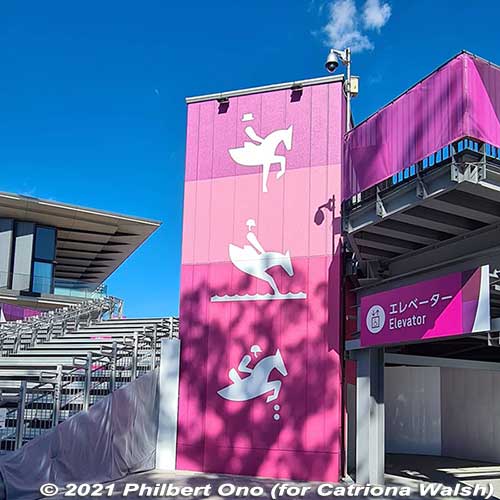
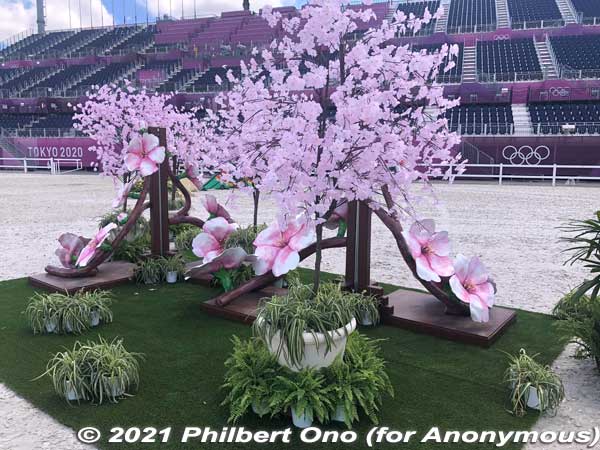
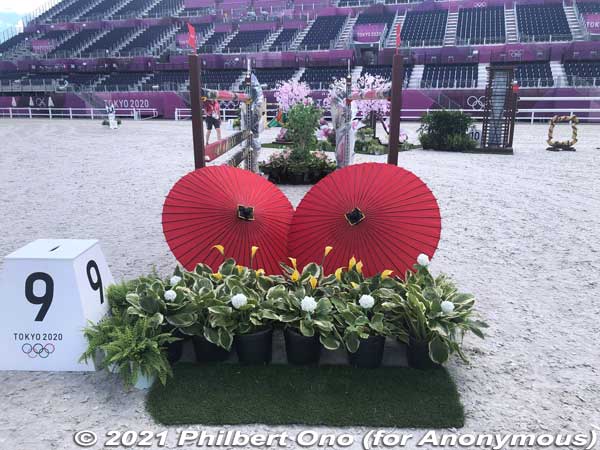
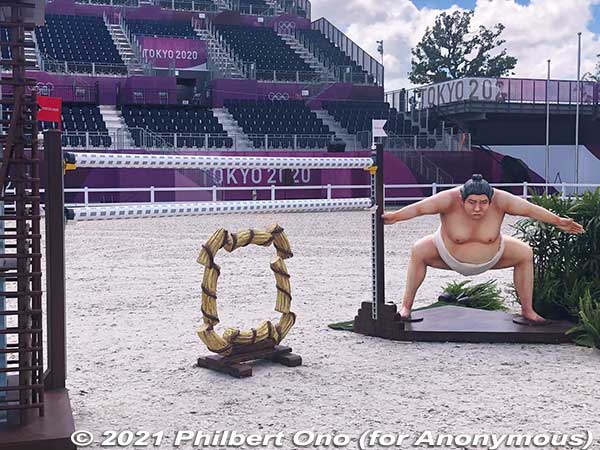



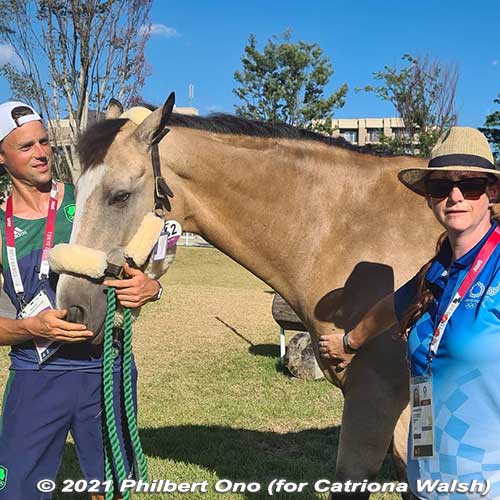
A: Pictograms at the entrance to Equestrian Park (Baji Koen in Setagaya).
B: The Olympic equestrian tradition is to have elaborate local-flavor decorations on the fences and obstacles for show jumping. For Tokyo 2020, they had many amusing Japanese elements such as cherry blossoms.
C: Paper umbrellas.
D: Sumo wrestler even. A few people thought the fake sumo wrestler spooked the horses on this jump.
E: Japanese folding fans. Other fences had kokeshi dolls, Tanabata streamers, and Himeji Castle.
F: Wall painting of Shizuoka Prefecture’s famous tea fields and Mt. Fuji. More photos of Tokyo 2020’s Japanese fences at World of Show Jumping.
G: Volunteer using a video camera to record dressage riders during their dressage tests for the dressage-only event. Footage is used for playback in case there are any queries about the judges’ scoring.
H: Irish rider Sam Watson and horse Danny and a volunteer.
Catriona Walsh (equestrian volunteer): “All the inconveniences that the pandemic visited upon athletes and volunteers alike were forgotten as the sport got underway. I forgot about all of this once I got to the venues which were stunning.”
Fuji Internatonal Speedway (FSW) (富士スピードウェイ) – Olympic/Paralympic Cycling Road Race
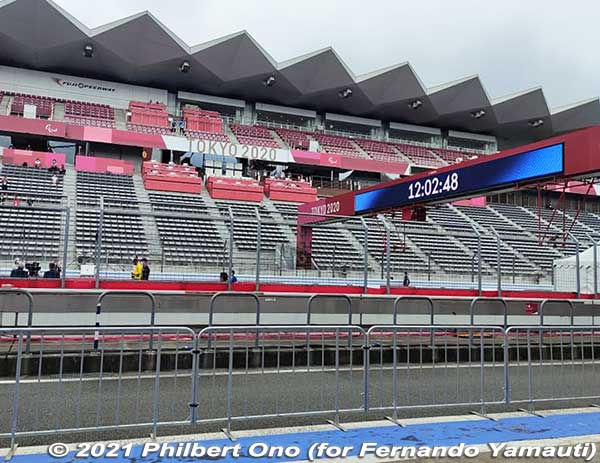

A: Finish line and grand stand. Olympic capacity was 22,000.
B: Japanese woman road cyclist Sugiura Keiko (C3) won gold in the Women’s C1-3 Time Trial on Aug. 31, 2021.
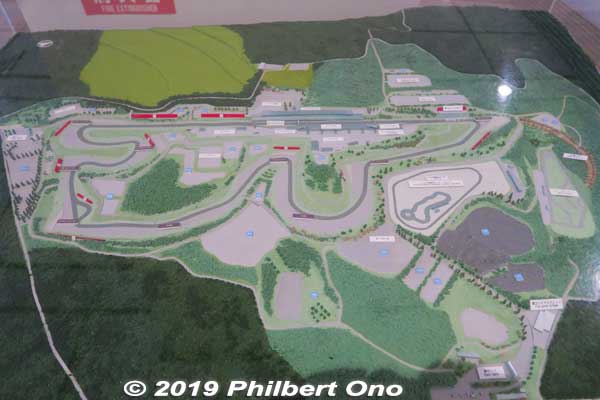
Fukushima Azuma Baseball Stadium (FAS) (福島あづま球場) – Baseball, softball
Ibaraki Kashima Stadium (IKS) (茨城カシマスタジアム) – Football/soccer


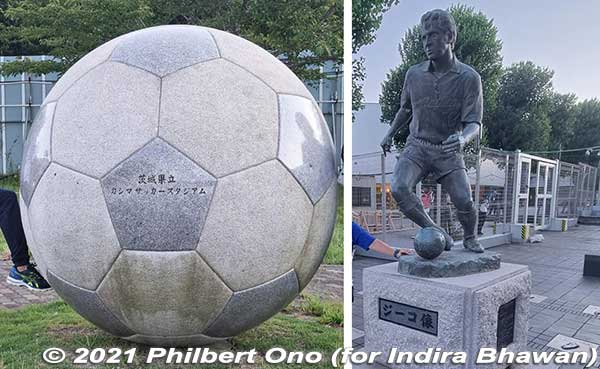
Ibaraki Kashima Stadium (Kashima Soccer Stadium) out in Kashima, Ibaraki Prefecture has a 40,000 capacity. Sadly, it was also empty during Olympic football here. A statue of superstar player Zico and a giant football are stadium trademarks (right photos). The stadium is home to pro soccer team Kashima Antlers where Zico played in the 1990s. Kashima Stadium is over 2 hours by train from central Tokyo.
International Stadium Yokohama (ISY) (横浜国際総合競技場) – Football/soccer
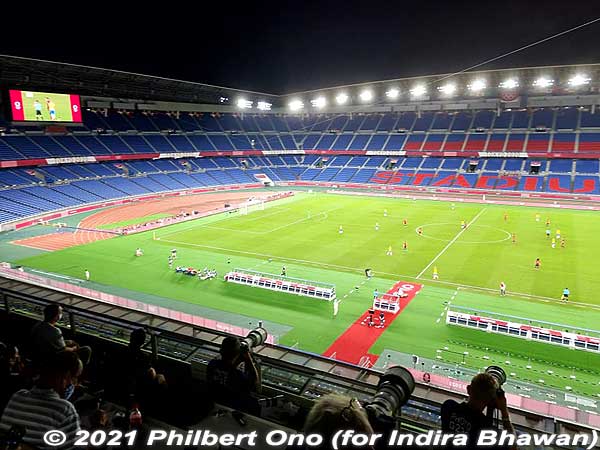

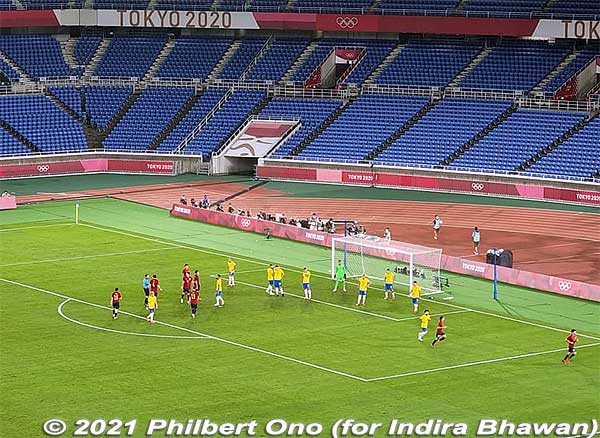
International Stadium Yokohama is one of Japan’s largest sports stadiums. Olympic capacity was 72,000. Normally, this stadium would be jam-packed. Photos show the Olympic men’s football/soccer gold medal match between Brazil and Spain on August 7, 2021. Brazil won the gold.
Izu MTB Course (IMB) (伊豆MTBコース) – Cycling (Mountain bike)
・Opened: June 1965 ・Location: Near Shuzenji Station (bus). ・Map ・Status: Reopened to the public from March 18, 2022.
Shuzenji has long been associated with pro cycling. Izu MTB Course was within the Japan Cycle Sports Center amusement park on the Izu Peninsula. The off-road course stretched 2,500 meters.
After Tokyo 2020, the MTB course was reverted back to normal use and the Cycle Sports Center reopened on March 18, 2022. The center also has cycling courses for kids, cycling monorail, unusual bicycles, putter golf course, and more. Izu Velodrome and pro bicycle racing (keirin) training facilities (Japan Institute of KEIRIN) are also in the park.
Izu Velodrome (IVD) (伊豆ベロドローム) – Olympic and Paralympic Track Cycling
・Opened: Oct. 2011 ・Location: Near Shuzenji Station (bus). ・Map ・Status: Open to the public.
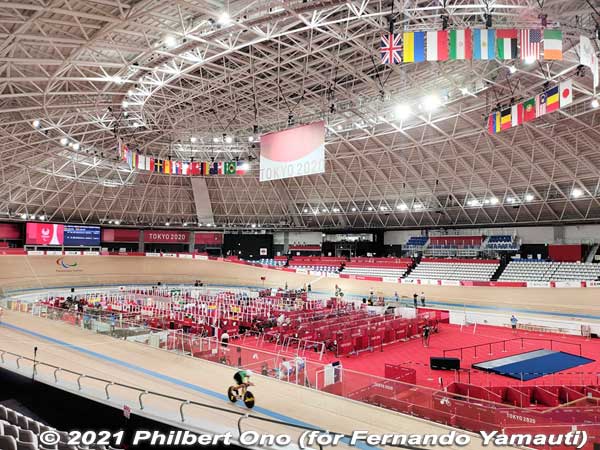
Izu Velodrome is unique in Japan for having a wooden cycling track (Siberian pine). Spectator seats are also close to the track for better enjoyment. To reduce venue construction costs, Izu Velodrome was selected for track cycling instead of building a velodrome in Tokyo. In Dec. 2015, it was approved for Olympic competition by the Union Cycliste Internationale (International Cycling Union).
Izu Velodrome was one of the few venues which allowed spectators during Tokyo 2020. It is within the Japan Cycle Sports Center amusement park on the Izu Peninsula. From March 18, 2022, the public can tour inside the facility.
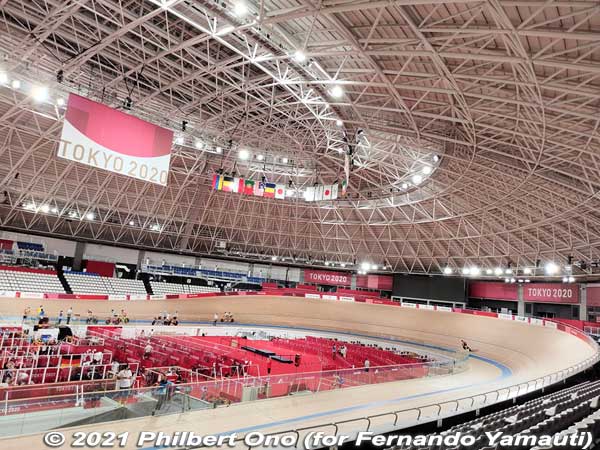
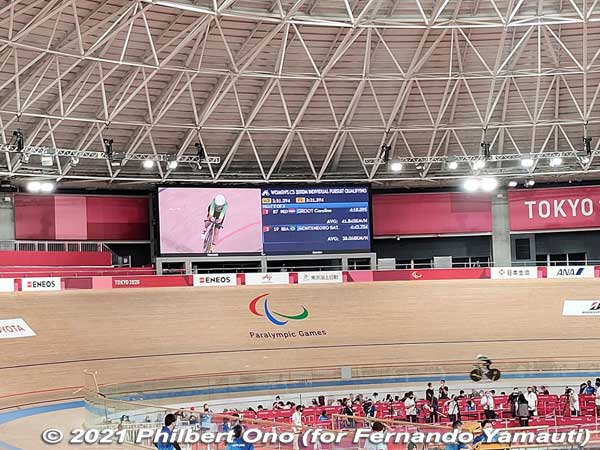
Izu Velodrome for Paralympic Track Cycling in Izu, Shizuoka Prefecture. Photos show Women’s C5 3000m Individual Pursuit Qualifying on Aug.25, 2021. Photos: Fernando Yamauti.
Kasumigaseki Country Club (KCC) (霞ヶ関カンツリー倶楽部) – Golf
・Opened: 1929 ・Location: Near Kasahata Station. ・Map ・Status: Open to club members.
Opened in 1929 as Saitama Prefecture’s first golf course. Named after the former Kasumigaseki Village which later merged with the city of Kawagoe. Japan’s first international golf tournament (Canada Cup) was held here in 1957.
The venue for Olympic golf at Tokyo 2020 was initially proposed to be the smaller Wakasu Golf Links in Koto City, Tokyo.
Since Kasumigaseki Country Club had not allowed female members, the IOC urged it to allow female members which it did in March 2017 when it changed its membership rules.
Kokugikan Arena (KKG) (国技館) – Boxing
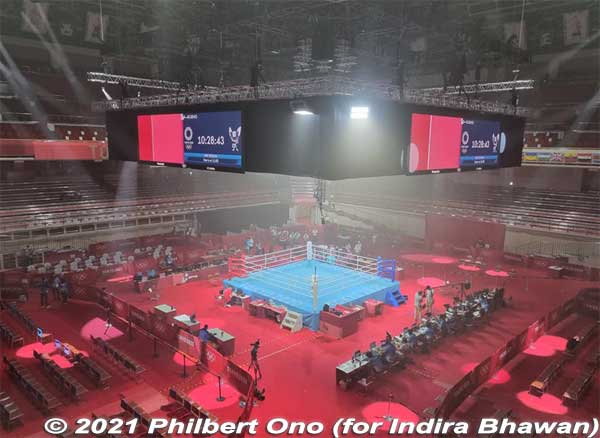

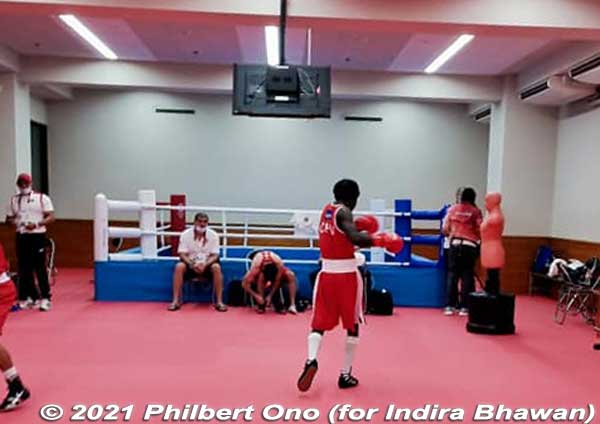
Kokugikan Arena looked interesting with a boxing ring instead of a sumo ring. Large portraits of champion sumo wrestlers decorated the arena. Extreme right photo shows a practice ring.
Built in 1985, the Ryogoku Kokugikan is a modern, spacious, and well-designed sumo arena where three of the six Grand Sumo tournaments are held in January, May, and September. It is a sleek, modern building with a spacious interior. The roof collects rainwater for use in the toilets. There is also a sumo museum open during sumo tournaments.
Makuhari Messe Hall A (MMA) (幕張メッセ Aホール) – Wrestling, Taekwondo, Sitting Volleyball
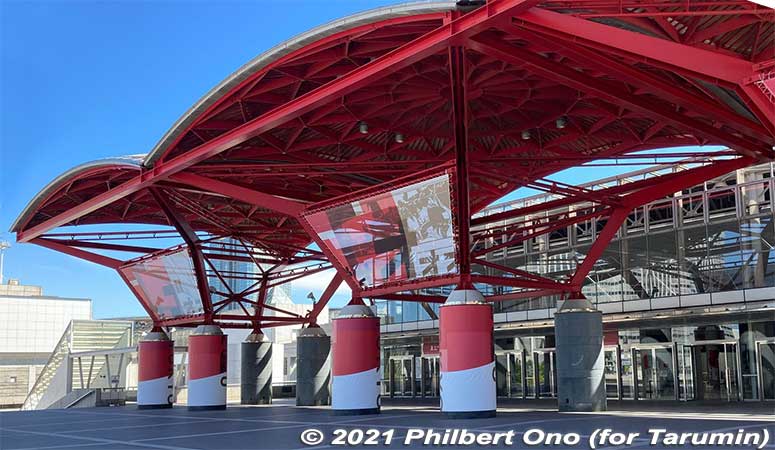
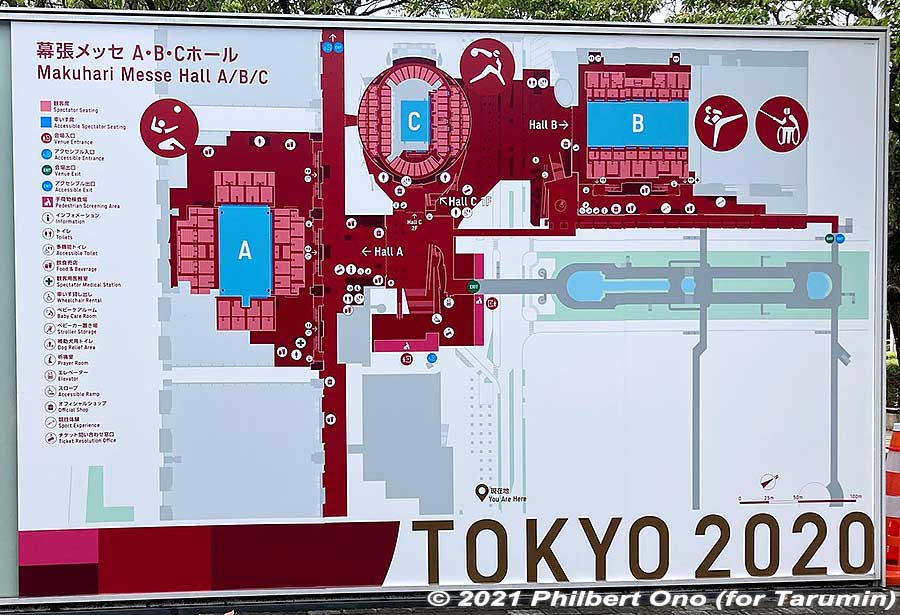
Left: Makuhari Messe Hall A for Olympic Wrestling and Taekwondo. The roof ceiling is originally painted red. The columns are covered with Kurenai red Look of the Games.
Right: Map of Makuhari Messe for the Paralympics showing Halls A, B, and C. Hall A is the largest in a long, rectangular building. Hall B is the second largest building connected by an elevated walkway. Hall C is oval and looks like a turtle shell. Paralympic Taekwondo was in Hall B. (For the Olympics, taekwondo was held in Hall A.) (Click/tap image to enlarge.)
Makuhari Messe in Chiba Prefecture is a large convention hall complex in the coastal Makuhari area of Chiba, the capital city of Chiba Prefecture. Along with Tokyo Big Sight, Makuhari Messe is one of Tokyo’s two biggest venues for trade shows.
Makuhari is a new and modern urban center on reclaimed land built up until 1980. The area saw major development from the latter 1980s with JR Kaihimmakuhari Station opening in 1986, Makuhari Messe opening in 1989, and Chiba Marine Stadium (baseball) opening in 1990. Makuhari now has office buildings, hotels, condos, and shopping malls. Wide streets, wide-open spaces, and artificial ocean beach.
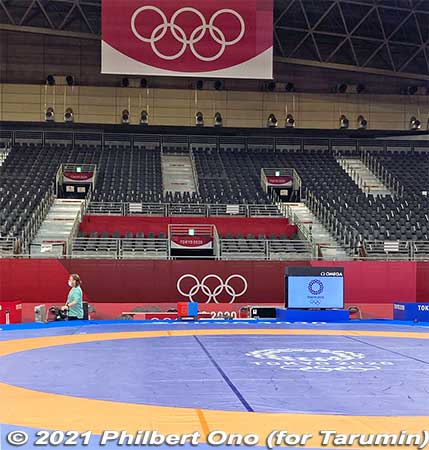
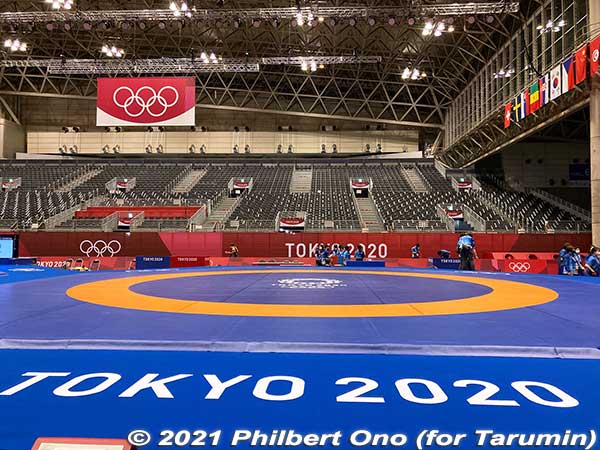
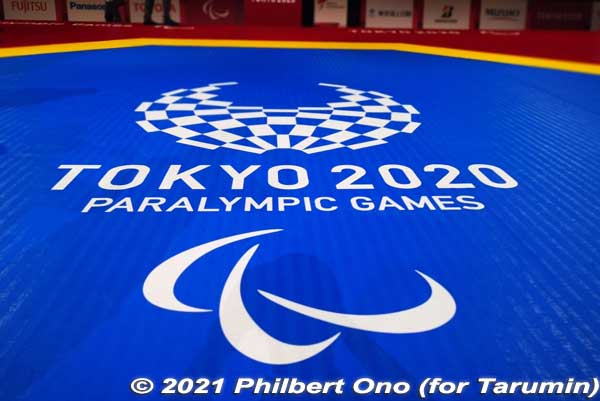
B: Makuhari Messe Hall B for Paralympic Taekwondo.
For Tokyo 2020, Makuhari Messe had three separate Halls A, B, and C for multiple sports. The three halls are interconnected with walkways. Hall A is the largest building, and Hall B is the second largest building. Hall C is oval and looks like a turtle shell. This is the smallest building, and normally called Makuhari Event Hall. Venue for goalball.
Makuhari Messe Hall B (MMB) (幕張メッセ Bホール) – Fencing, Paralympic Taekwondo, Wheelchair Fencing
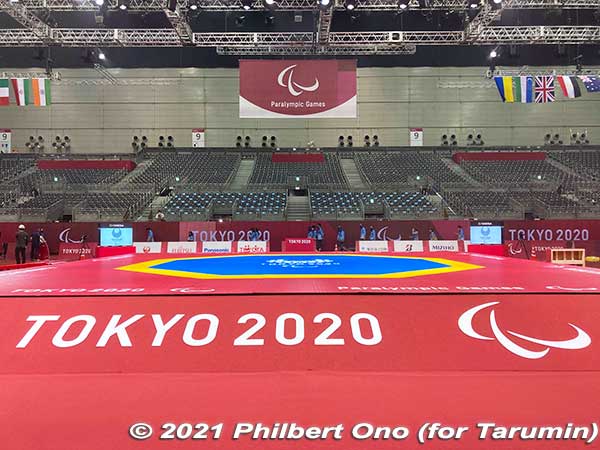
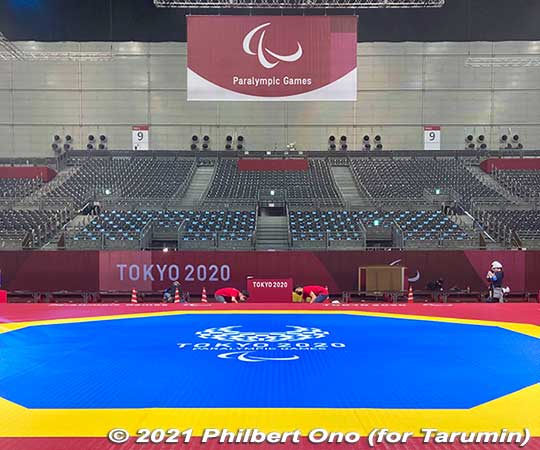
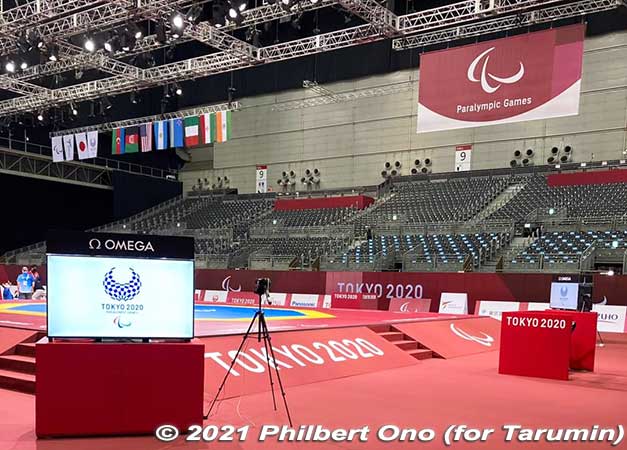
Miyagi Stadium (MIS) (宮城スタジアム) – Football/soccer
Musashino Forest Sport Plaza (MFS) (武蔵野の森総合スポーツプラザ) – Badminton, Modern pentathlon (épée fencing ranking round), wheelchair basketball
Musashinonomori Park (MUP) (武蔵野の森公園) – Cycling road race (start)
Nippon Budokan (NBK) (日本武道館) – Judo, Karate
・Opened: Oct. 1964 ・Location: Near Kudanshita Station. ・Map ・Status: Open to the public for events.
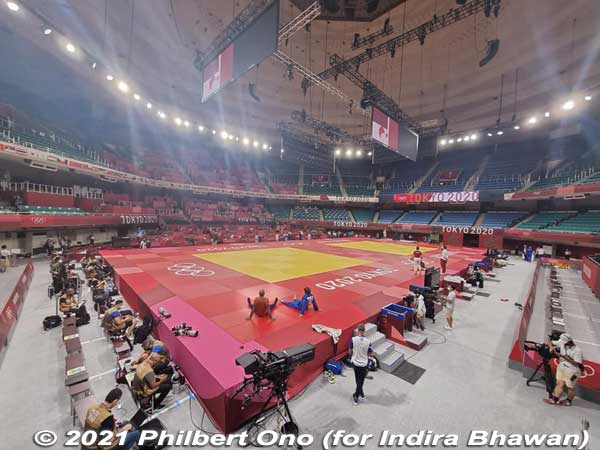
Legacy venue since it was built and used for judo during the 1964 Tokyo Olympics. Famous as the venue where The Beatles played in 1966.
The Budokan completed major renovations in late July 2020 for earthquake resistance and to install LED lighting, more wheelchair seating, and wheelchair accessible toilets.
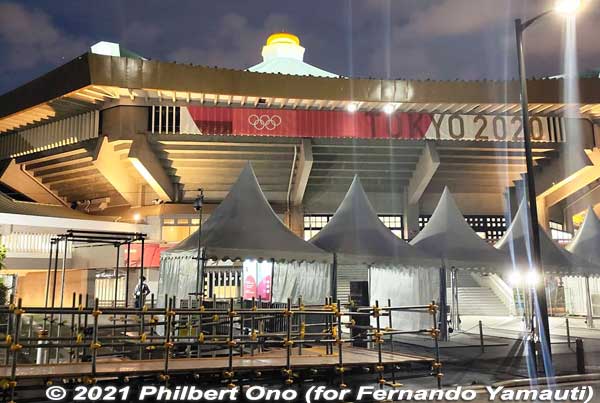
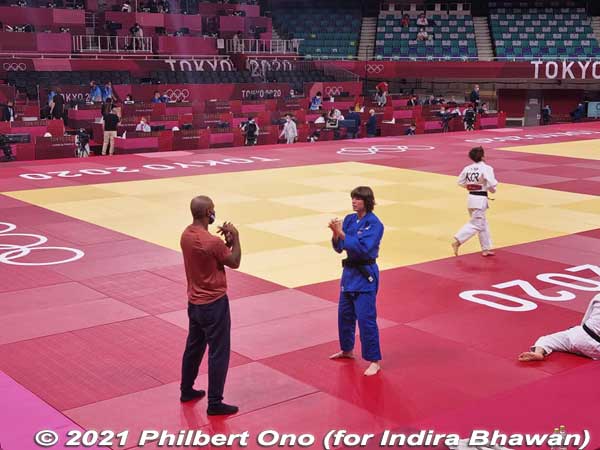
The famous Nippon Budokan is a legacy venue originally built for judo at the Tokyo 1964 Olympics. It has since become an exalted venue for Japanese martial arts as well as for rock concerts starting with The Beatles in 1966. Major renovations were completed in late July 2020 for earthquake resistance and to install LED lighting, more wheelchair seating, and wheelchair accessible toilets. Photos show judo.
Odaiba Marine Park (OMP) (お台場海浜公園) – Olympic/Paralympic Triathlon, Marathon Swimming
・Opened: 1975 (Current form from 1996)・Location: Near Daiba, Odaiba Kaihin Koen, Tokyo Teleport, and Aomi Stations. ・Map ・Status: Triathlon and marathon swimming venues dismantled. Beach area reopened to the public on Jan. 1, 2022.
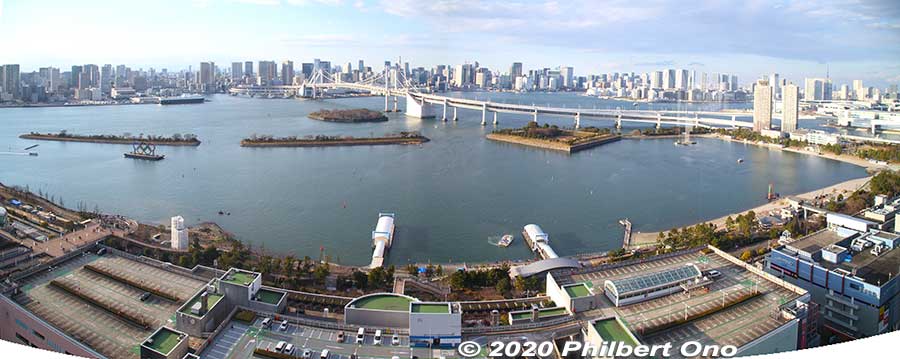
Odaiba is a large waterfront area built on man-made islands. For many years, the area was a backwater with only the boat-shaped museum (now closed) and beginner windsurfers. The area developed rapidly after the opening of the Yurikamome train line and Rinkai Line in the mid-1990s. Odaiba has become one of Tokyo’s major tourist attractions with waterfront parks, beaches, large shopping malls, hotels, and wide-open spaces. It is a perfect place for a triathlon (when the ocean is clean).
Odaiba has an interesting history. Near the Rainbow Bridge, you can see two small, square man-made islands in Odaiba. They were hastily built in 1853 as military defense outposts by Japan’s waning samurai government to fight off any invasion of Tokyo by the US Navy (led by Commodore Perry) which came knocking on Japan’s door earlier that year. The naval invasion never came, and the outposts were never used in battle.
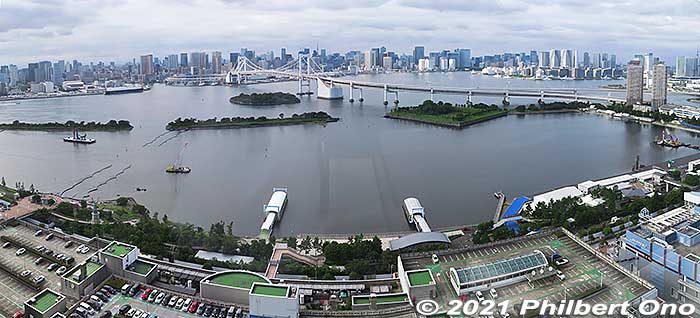
Odaiba is scenic with Rainbow Bridge and the Tokyo skyline in the background. Major sights include waterfront walking paths and beaches (closed during the Games), a Statue of Liberty replica, a giant Gundam statue, Miraikan science museum, and a giant ferris wheel.
Being close to many of the waterfront venues with public transportation, Odaiba was the hub of “Tokyo Bay Zone” venues. Odaiba was Tokyo’s closest thing to an Olympic Park. It’s no wonder that they installed the giant Olympic rings (or Agitos). The Olympic rings (or Agitos) lit up at 6:15 pm nightly until midnight. During the Games, they were lit up until 5 am.
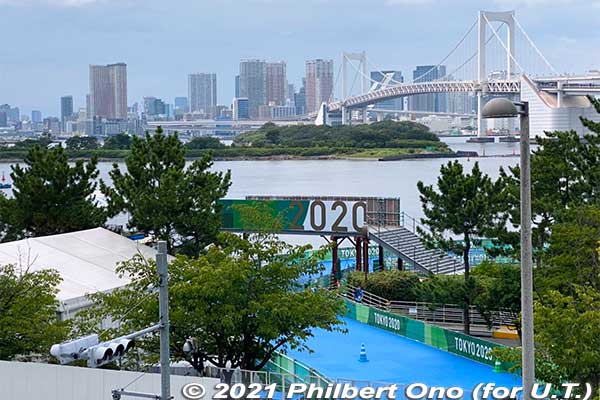
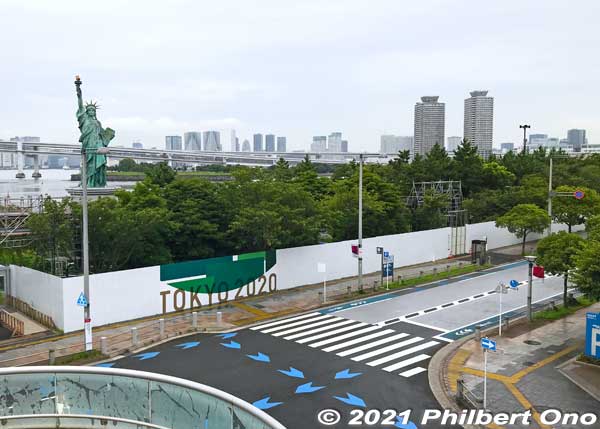
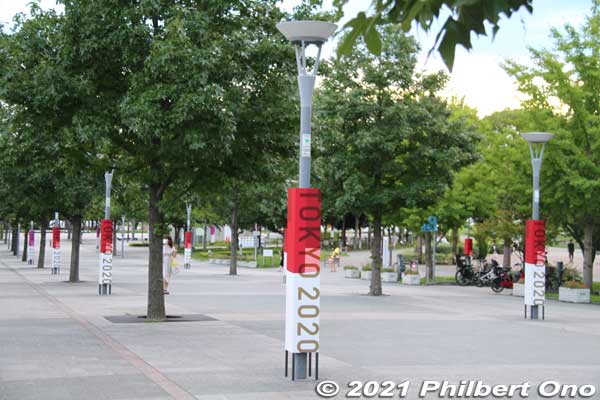
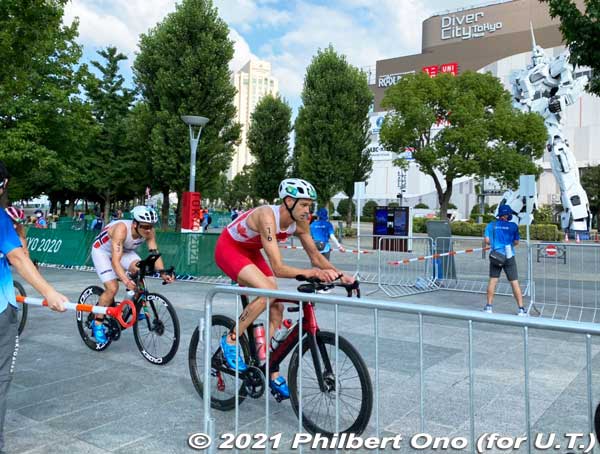
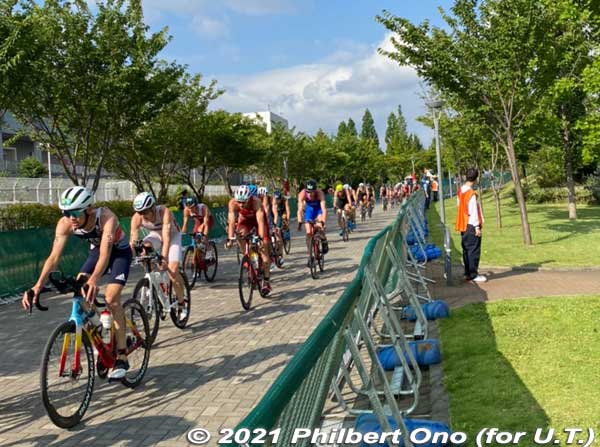
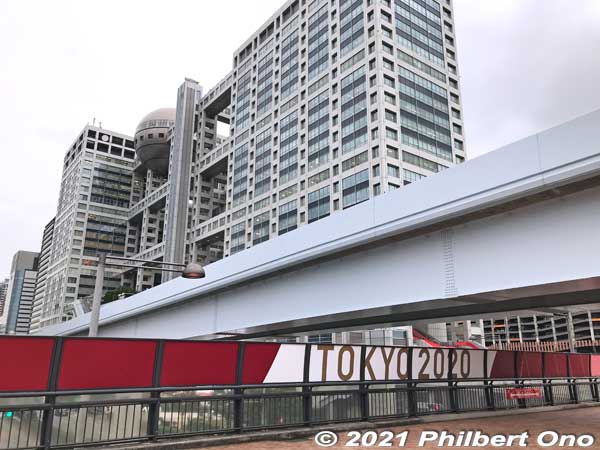
A: Odaiba Marine Park (OMP) for triathlon and marathon swimming. The blue turf was where athletes rode their bicycles from the beach to the road. Look of the Games was pine green.
B: Statue of Liberty also fenced in at Odaiba Marine Park.
C: Triathlon cycling route near Diver City mall.
D: Olympic triathlon cyclists passing by Gundam (Diver City).
E: Olympic Triathlon cycling in Odaiba.
F: Fuji TV building is a major landmark. The lookout deck (admission charged) on the top floor has great views of the area.
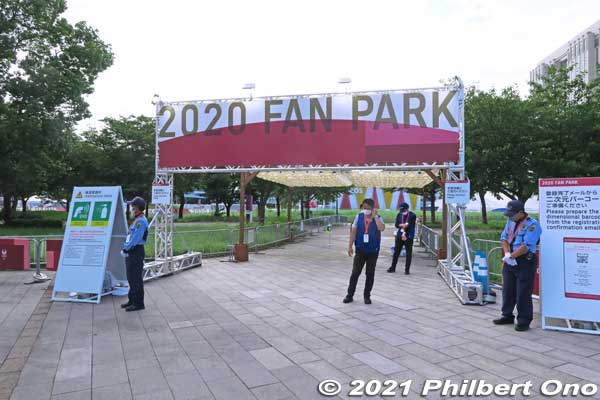
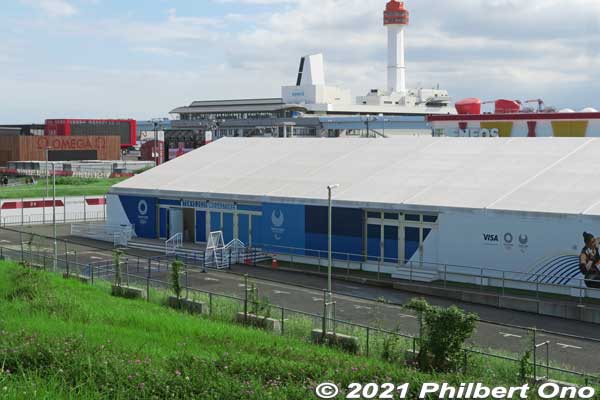

G: 2020 Fan Park entrance. Pre-registration required for entry. Corporate pavilions (Omega, Eneos, etc.) in the park were for employees only.
H: In 2020 Fan Park, Tokyo 2020 official megastore with merchandise.
I: 2020 Fan Arena was a large interactive space for the public. Hands-on sports demonstrations. Only registered Tokyo residents could enter.
Shiokaze Park (beach volleyball venue) is a short walk away. A short train ride from Odaiba (Daiba, Odaiba Kaihin Koen, Tokyo Teleport, or Aomi Station) can take you to Tokyo Big Sight (media centre), Ariake Tennis Park, Ariake Urban Sports Park, Aomi Urban Sports Park, Ariake Arena, Ariake Gymnastics Centre, Tokyo Aquatics Centre, Tatsumi Water Polo Centre, and Yumenoshima Park Archery Field. The Olympic Village was also a stone’s throw away from Odaiba.
Two train lines serve Odaiba: JR Rinkai Line running from places like Shinjuku, and Yurikamome Line running between Shimbashi and Toyosu. The Yurikamome Line is quite scenic when crossing Rainbow Bridge overlooking Odaiba. Both train lines connect to major train and subway lines.
There are also local buses that go to Odaiba from rail stations like Tokyo Station, Monzen-Nakacho Station (Tozai subway line), and Oimachi and Omori Stations (Keihin-Tohoku Line).
Odaiba is on flat, reclaimed land, created mostly with seabed sediment dredged from Tokyo Bay to make the bay’s shipping lanes deeper. Before it saw major development from the 1990s, it was a popular place for windsurfers. Modern urban planning created wide open spaces, wide roads, and convenient public transportation.
Odaiba Marine Park was one of the few venues that benefited from the one-year postponement. It had more time to improve its water quality in the ocean more marathon swimming and the triathlon.
In August 2019 when Olympic and Paralympic test events were held in Odaiba, athletes complained about the foul-smelling ocean. The foul odor becomes especially apparent when the sludge on the ocean bottom is stirred up. Not only that, the murky water was found to have more than twice the acceptable level of E. coli bacteria, forcing the Paralympic triathlon test event’s swimming portion to be canceled. The summer heat was also a problem for a few athletes coming down with heat exhaustion. A triple whammy.
The problem with Odaiba is that it’s somewhat near a sewage treatment plant (Shibaura Water Reclamation Center near Shinagawa Station) whose effluent is discharged into the ocean that flows to Odaiba.
This sewage treatment plant receives sewage and rainwater runoff from a large area of central Tokyo. When there’s heavy rain, the plant does not have enough capacity to adequately treat all the sewage and rainwater. So it is forced to discharge the excess rainwater without much treatment.
This results in a muddy-brown ribbon of water and some of it flows to Odaiba. So Odaiba’s water quality gets bad after heavy rains. When there’s no rain, the sewage treatment plant is able to treat and cleanse all of the wastewater before discharging it into the ocean. So the water odor and E. coli bacteria level in Odaiba can vary widely depending on the weather. This problem has been known for many years, but no effective measures have been implemented.
To try and mitigate the effects of the effluent, three containment booms (floating fences) were placed in parallel near the sewage treatment plant’s effluent discharge outlet and clean sand from Kozushima island (south of Tokyo) was brought in to cover Odaiba’s ocean sludge. The E. coli bacteria level has gone down and athletes swam in the water during the Games.
Oi Hockey Stadium (OHS) (大井ホッケー競技場) – Field Hockey
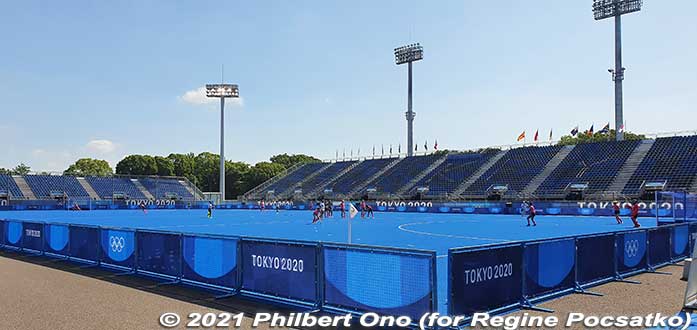
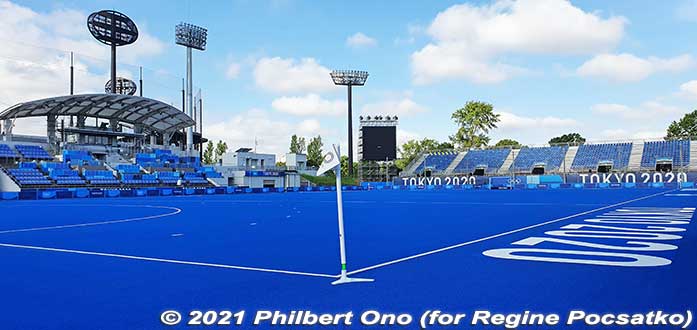

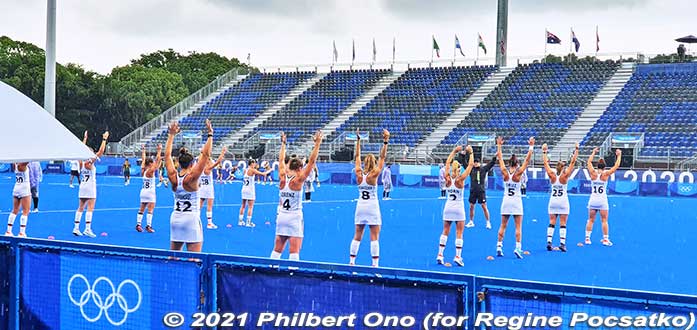
Oi Hockey Stadium has the North and South Pitches for the competition, one warm-up pitch, and one training pitch.
A: North Pitch.
B: South Pitch.
C: Netherlands women’s hockey team in orange doing their warm-up routine while wearing “cooling jackets.” They later won the gold medal.
D: German women’s hockey team doing warm-up exercises.
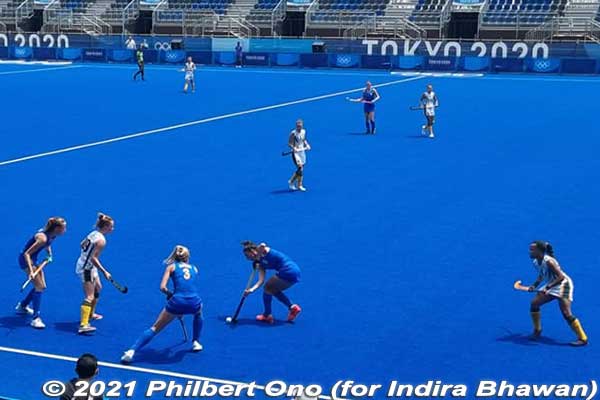
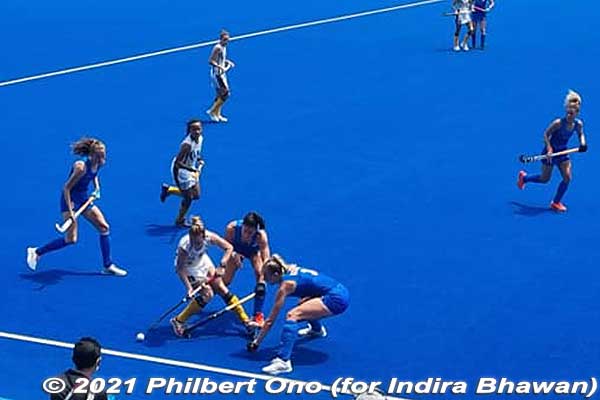
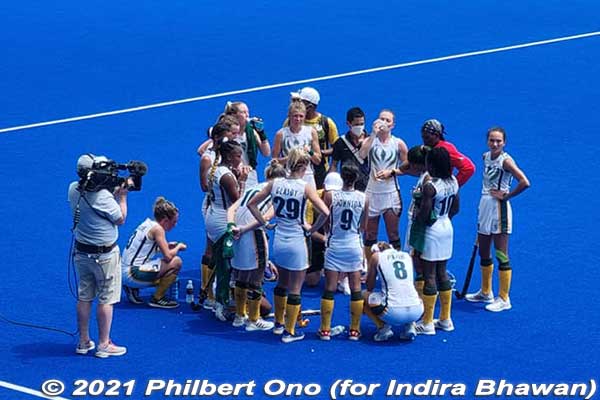
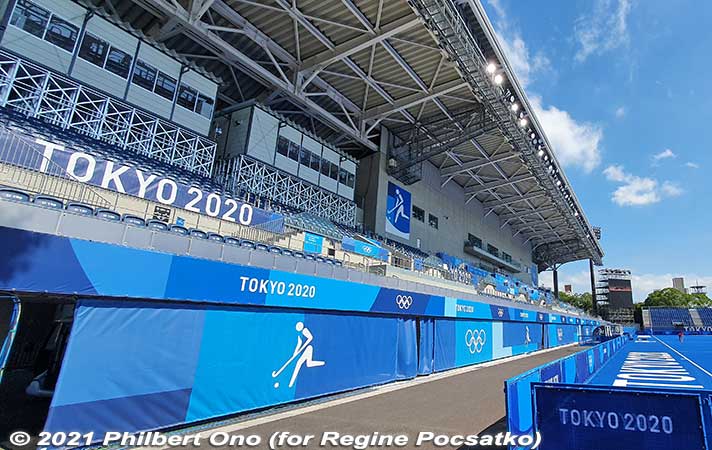
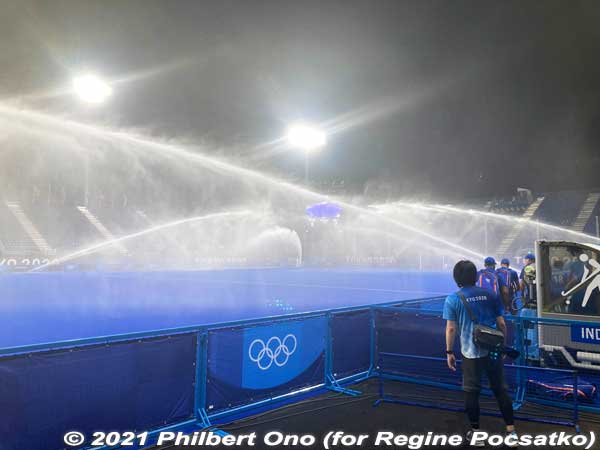
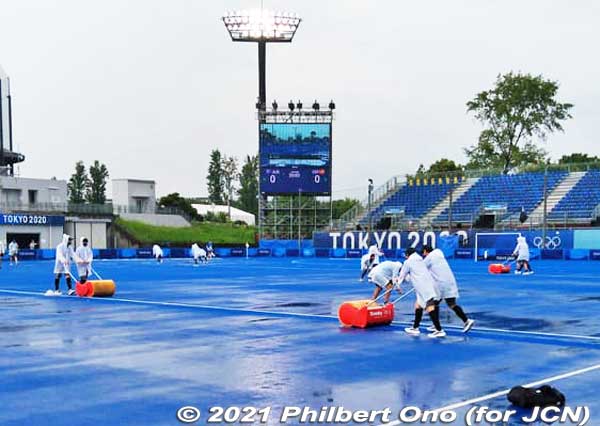
A: Women’s field hockey match between South Africa (white) and Netherlands (blue) on July 28, 2021.
B: South Africa women’s field hockey team timeout.
C: North Pitch stands.
D: The pitch has state-of-the-art, water-based, short-pile artificial turf. The turf is watered before hockey matches. (Photos by Regine Pocsatko.)
E: Volunteers removng rainwater from the pitch. (Photo by JCN.)
Olympic Stadium (OLS) (オリンピックスタジアム、国立競技場) – Athletics, Football/soccer
・Opened: Dec. 2019 ・Location: Near JR Sendagaya and Kokuritsu Kyogijo Station. ・Map ・Status: Reverting to National Stadium until end of March 2022, then it will be open to the public for events.


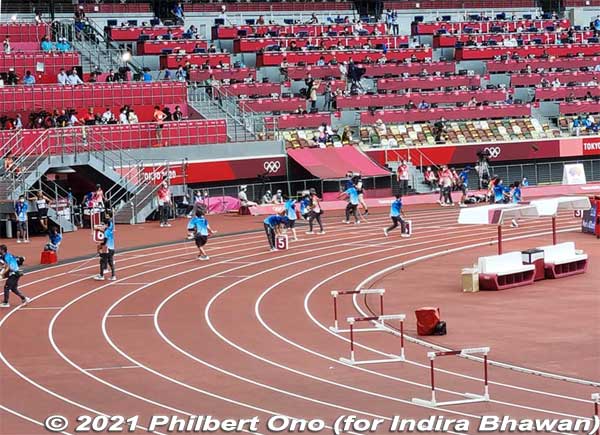
Olympic Stadium (Japan National Stadium) had Kurenai red look. Photos shows hurdles.
Right: Volunteers take away the runner number plates from the track. (Photos by Indira Bhawan.)
Owned by the Japanese government and officially named “Japan National Stadium” (国立競技場), the new Olympic Stadium replaced the old National Stadium that was used for the 1964 Tokyo Olympics. It was built on the same spot as the old National Stadium. Due to some controversy over the initial design by Zaha Hadid, the construction was delayed and the stadium was not completed in time for Rugby World Cup 2019.
Hadid’s design was criticized for being too expensive and intrusive (70 meters high) for the surrounding area. She later scaled it down, but since she could not find any local construction companies to work with, she withdrew her bid.
Architect Kuma Kengo (who was one of the people opposing Hadid’s stadium design) won the bid and his stadium design theme was “Forest Stadium” (杜のスタジアム) with a relatively low profile. Lots of cedar lumber on the exterior. The wood came from all 47 prefectures and they point toward the place where they came from. With numerous 10-cm wide lumber spaced closely together, the wooden roof eaves were modeled after Japanese Buddhist temple roof eaves.
Empty stadium seats reveal the random mosaic pattern of seat colors in shades of green, brown, and white like fallen autumn leaves. It makes it look like there are spectators. (Maybe a premonition of a spectatorless Games.) The stadium is also wheelchair accessible with wheelchair spaces around the stands.
The fixed roof covers all of the spectator seats and also carries the crowd’s cheers, so we can hear the cheers quite well throughout the stadium.
The new National/Olympic Stadium opened to the public for the first time on on Dec. 21, 2019 with an opening event called “Hello, Our Stadium.” A three-hour evening of culture (Tohoku festivals), music (J-pop groups), and track runners (relay race by track stars including special guest Usain Bolt).
After the Games, the Olympic Stadium will revert back to being the National Stadium and be retrofitted for soccer/football and rugby. The new stadium uses natural grass turf and the track was made by an Italian company, reputed to be “fast” for runners. There was some debate over whether the track should be retained or not, but the track will likely be retained.
After a bidding process, a private company is to be selected to sign a concession agreement to manage the Olympic Stadium. Having a private company operate and manage the stadium aims to defray the high maintenance cost of the stadium estimated to be ¥2.4 billion/year for 50 years including repairs. This is over twice the old National Stadium’s annual maintenance cost of ¥1.1 billion.
The seating capacity supposed to be increased to 80,000. Not too many sports and concerts will need this much capacity. And if the number of spectators has to be limited for social distancing, it will reduce ticket revenue and profitability.
The government is also considering to sell naming rights to the stadium, so it might not be called the “National Stadium” (Kokuritsu kyōgijō) anymore.
On February 9, 2022, TMG approved a plan to redevelop the Jingu Gaien area around the National Stadium with high-rise offices and hotels and a new baseball stadium and rugby stadium. Over 1,000 trees would be cut down or transplanted and the old Jingu baseball stadium and Chichibu Rugby Stadium would be rebuilt anew. Buildings will tower as high as 190 meters in the sky. The greenery will be restored for the most part.
More photos of National Stadium here.
Saitama Stadium (SAS) (埼玉スタジアム2002) – Football/soccer
・Opened: Oct. 2001 ・Location: Near Urawa-Misono Station. ・Map ・Status: Open to the public for events.
Built mainly for soccer, Saitama Stadium was one of the venues for the 2002 FIFA World Cup. Spectator seats are set close to the pitch. Home stadium for local soccer J-League team Urawa Red Diamonds. Capacity 63,700 including 150 wheelchair spaces.
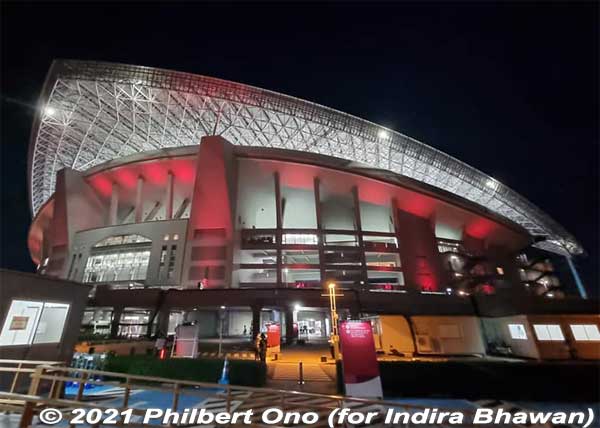
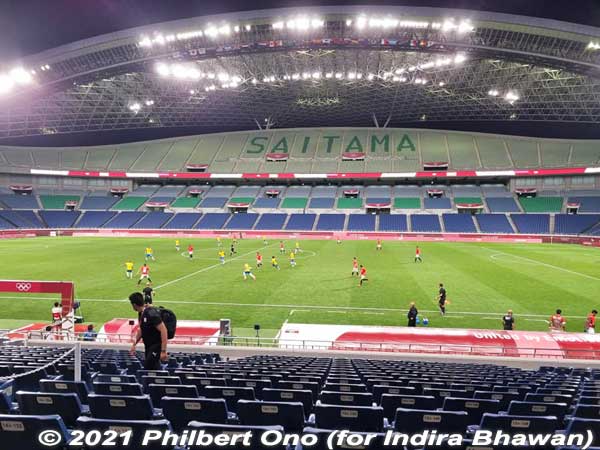
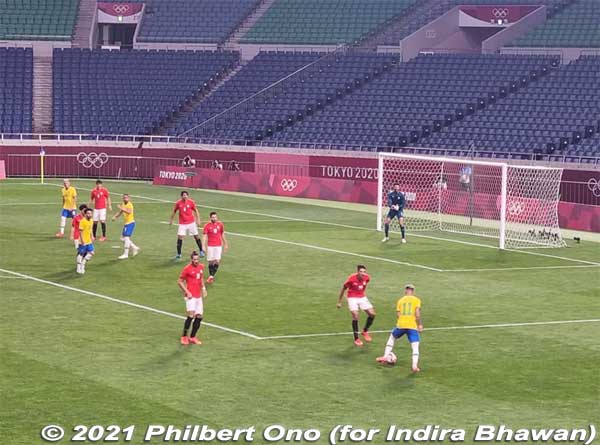
Photos show an Olympic game between Brazil and Egypt on July 31, 2021.
Saitama Super Arena (SSA) (さいたまスーパーアリーナ) – Basketball
・Opened: Sept. 2000 ・Location: Near Saitama Shintoshin Station. ・Map ・Status: Open to the public for events.
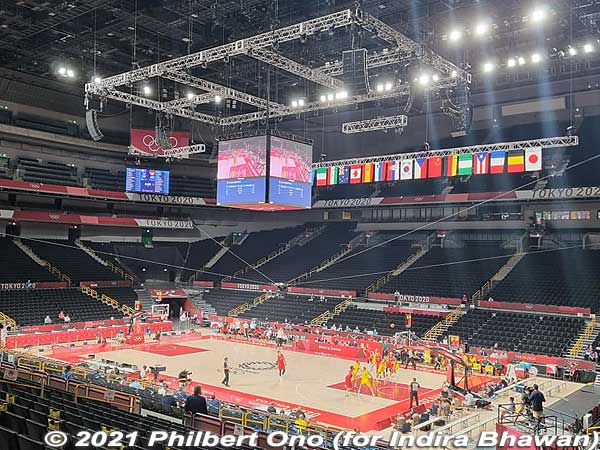
Saitama Super Arena is unique for its ability to expand or shrink the seat capacity. There is a huge movable section of seats, and the ceiling can also move vertically to expose or hide the upper tier of seats. Popular and profitable venue for sports and concerts. Since 2018, it has served as the venue for major Japanese basketball championships. Olympic capacity was 21,000. Convenient location near Saitama Shintoshin Station.
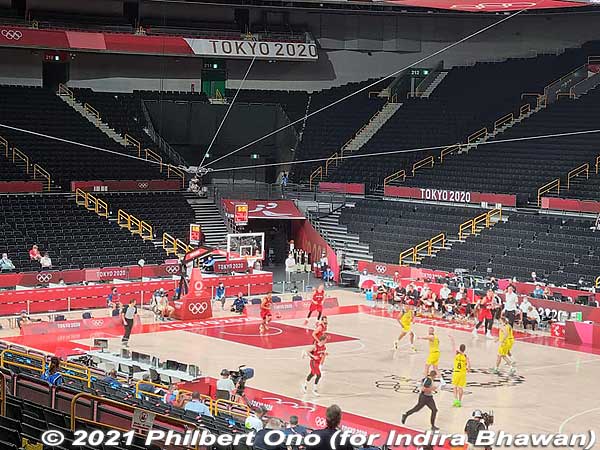

Photos show men’s Olympic basketball game with Australia (yellow jersey) defeating Germany (red) on July 31, and Spain (white) and USA (blue) on Aug. 3. USA later won gold. (Photos by Indira Bhawan.)
Sapporo Dome (SDO) (札幌ドーム) – Football/soccer
Sapporo Odori Park (SOP) (札幌大通公園) – Marathon, race walk
Sapporo’s most famous and popular park about 1.5 km long east to west with Sapporo TV Tower on one end. A real oasis in the city, especially during the warmer months with water fountains, flowers, green grass, and sunshine. Also the site of the annual Sapporo Snow Festival in Feb.
Sea Forest Cross-Country Course (SFC) (海の森クロスカントリーコース) – Equestrian (Eventing)
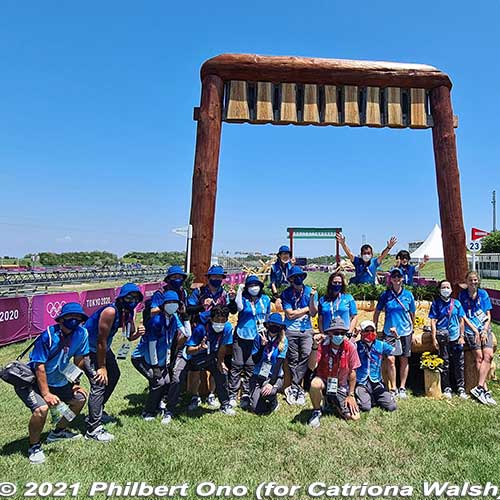
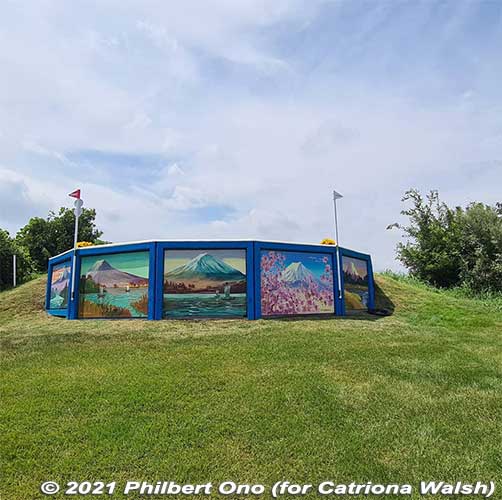
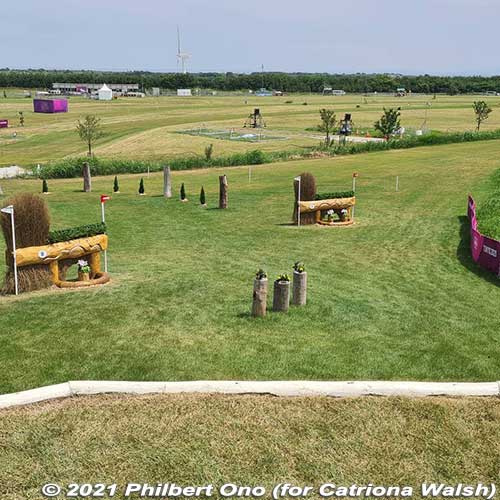
Sea Forest Cross-Country Course was a 4.4-km equestrian obstacle course, shortened from the usual 5,700m due to summer heat concerns. Photos by Catriona Walsh.
A: Mt. Fuji drop decorated with Mt. Fuji paintings, perhaps the most photographed obstacle on the course. (The horse leaped over this from behind.)
B: Sea Forest Cross-Country Course as seen from the Mt. Fuji drop.
Sea Forest Waterway (SFW) (海の森水上競技場) – Rowing, Canoe (Sprint), Paralympic Rowing/Canoe

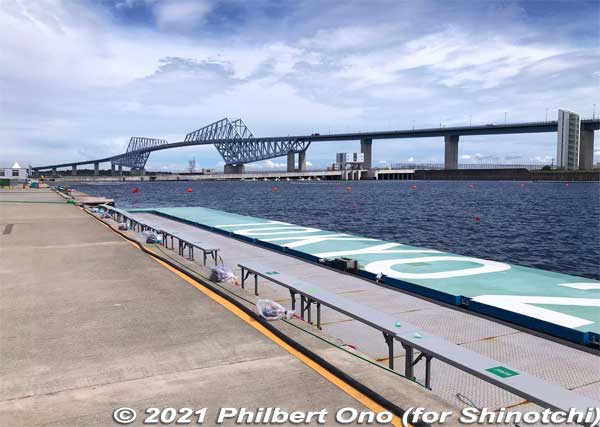
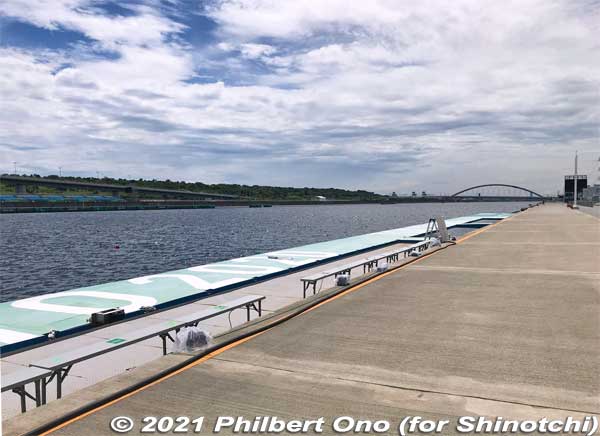

A: View toward the finish line with Tokyo Gate Bridge in the background.
B: View toward the start line.
C: Main stand. Look of the Games was Pine Green.

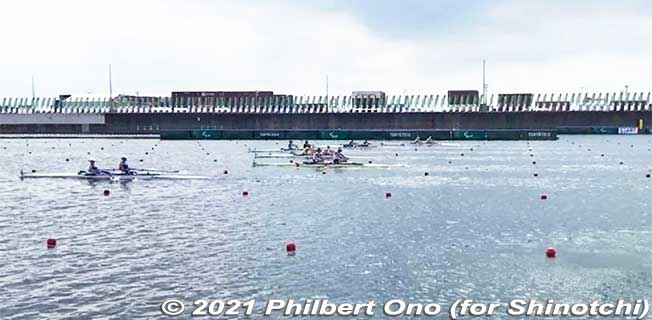
E: Double scull leaving the start line.
Shiokaze Park (SHP) (潮風公園) – Beach Volleyball
Tatsumi Water Polo Centre (TWC) (東京辰巳国際水泳場) – Water Polo
・Opened: Aug. 1993 ・Location: Near Shin-Kiba and Tatsumi Stations. ・Map
・Status: Reopened on Oct. 1, 2021 as a public swimming pool. Closed permanently on March 30, 2023 to become an ice skating rink. Swimming competitions in Tokyo will now use Tokyo Aquatics Centre.

Tatsumi Water Polo Centre (TWC) was the Tokyo Tatsumi International Swimming Center (東京辰巳国際水泳場) that was retrofitted for water polo at Tokyo 2020. Until the new Tokyo Aquatics Centre was completed, TWC was Tokyo’s main pool for major aquatics competitions.
Tokyo Tatsumi International Swimming Center underwent major renovations from Nov. 2018 to March 2019. There was a minor controversy about the use of asbestos in the building, but it was deemed safe since people do not normally go to where there is asbestos.
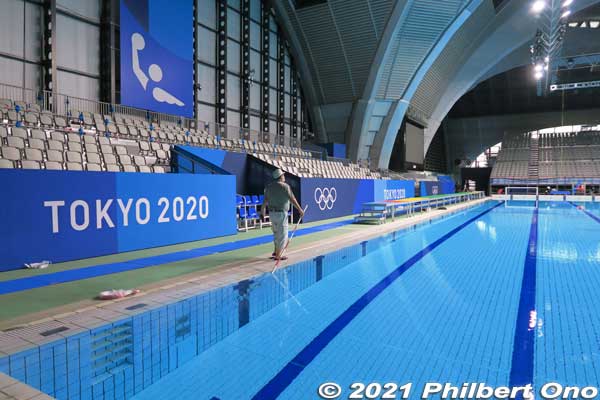
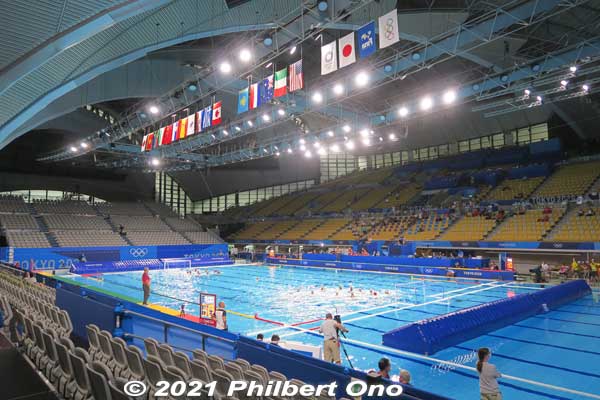

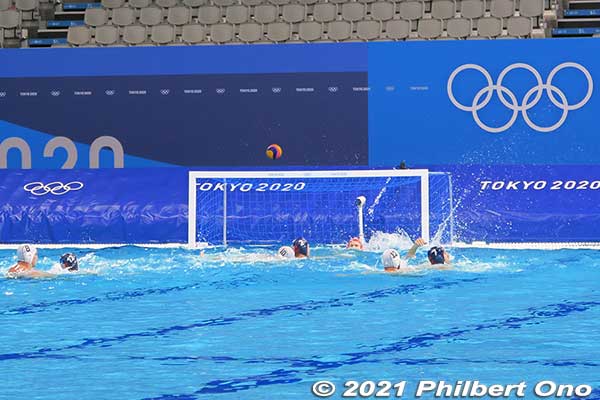
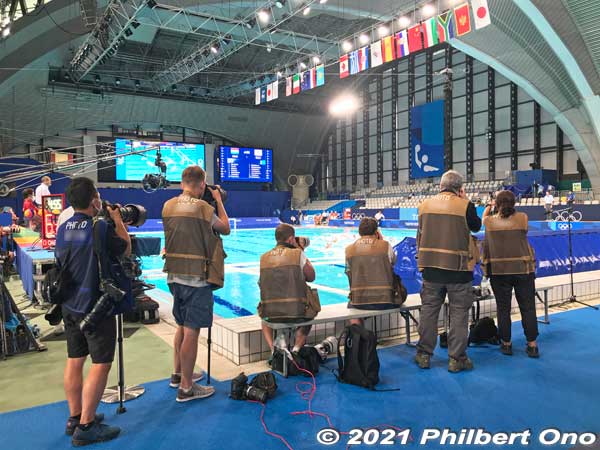
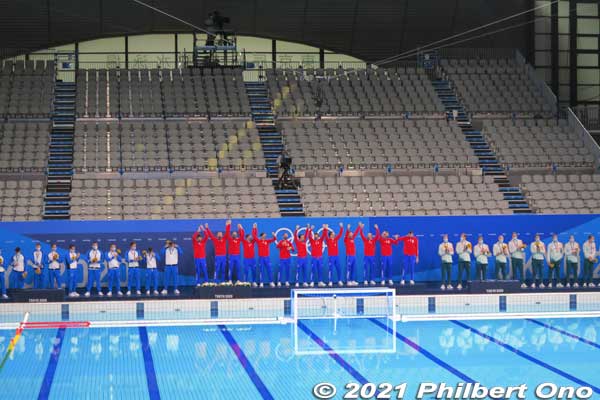
A: TWC had a beautiful Indigo blue for the Look of the Games, including a large water polo pictogram. The stands on the left were temporary.
B: Main pool has a permanent grandstand with yellow seats. Seats on the left end were temporary, built over the empty diving pool.
C: Main pool as seen from one end.
D: Water polo match.
E: At the Olympics/Paralympics, accredited photographers must all wear a numbered photo vest issued by the organizer to enter the venue and access the photo positions. Those wearing a navy blue vest were from major news agencies and were given priority. Some photo positions also provide Internet cabling for photographers to connect their cameras and transmit their photos in real time to their editors.
F: Men’s water polo medalists on the podium. Serbia (Gold), Greece (Silver), and Hungary (Bronze).
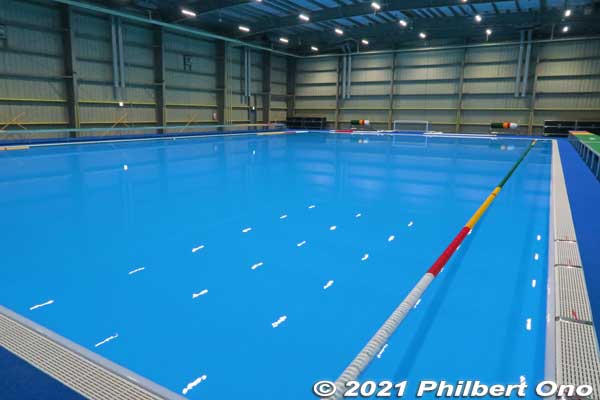
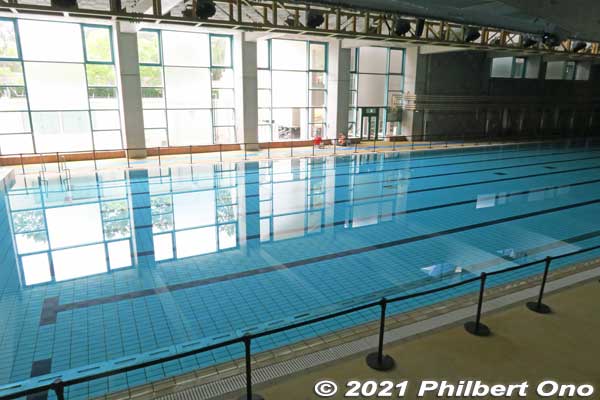
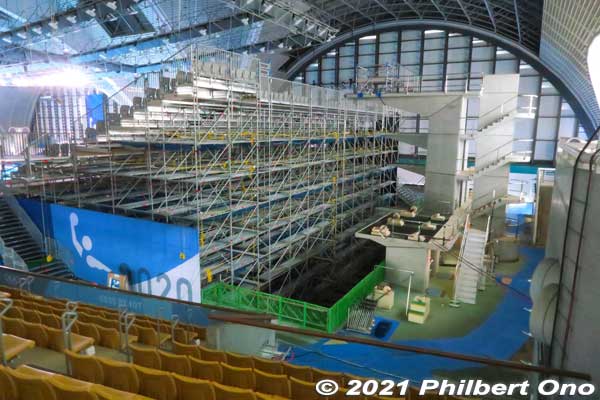
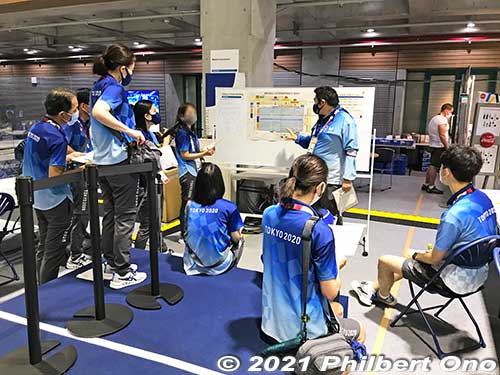
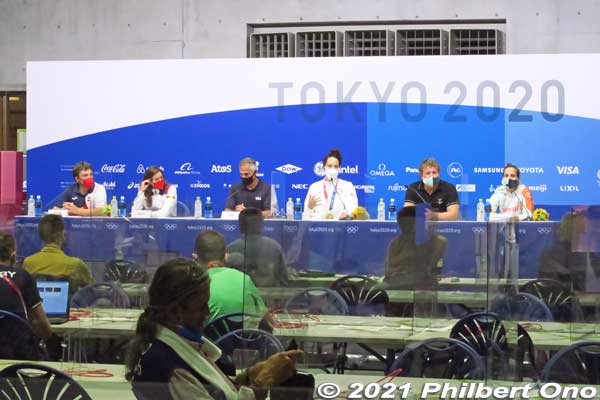
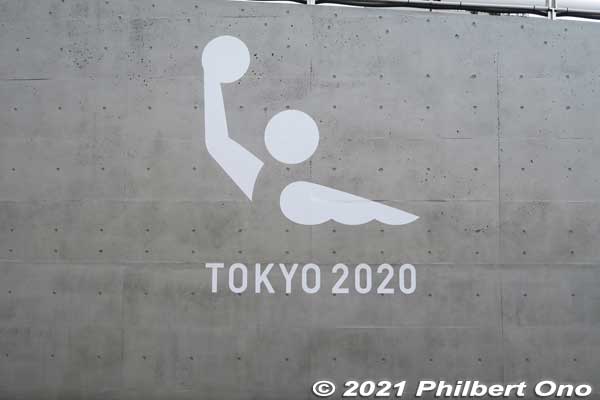
G: Warm-up pool (temporary structure) was outside next to Tatsumi Water Polo Centre.
H: Cool-down pool was in the basement near the main pool.
I: Rear view of the temporary spectator stand covering the diving pool. Diving platforms on the right.
J: Briefing for Press Operations volunteers who would help at the victory/medals ceremonies.
K: Press conference for men’s water polo medalists.
L: Large water polo pictogram on a concrete wall.
Tatsumi Water Polo Centre and the new Tokyo Aquatics Centre (TAC) are on reclaimed land on Tokyo’s waterfront full of artificial islands. Major portions of Tokyo are reclaimed land built over the centuries. (Odaiba, the Olympic Village, and Tokyo Big Sight are also on reclaimed land.)
Tatsumi Water Polo Centre (TWC) is on an artificial island named “Tatsumi” (辰巳). It was built and developed in the 1960s and 1970s. “Tatsumi” means “Southeast.” It was the nickname of the neighboring district called “Fukagawa” which was southeast of the shogun’s Edo Castle (now Imperial Palace). Fukagawa is in the area of Monzen-Nakacho Station on the Tozai subway line, and Tatsumi is considered to be part of the Fukagawa district. Much of Tatsumi island is a public park and both TWC and TAC are in the Tatsunomori Seaside Park. South of TWC is also a green belt park noted for many cherry blossoms in spring.
Another notable area next to Tatsumi is Shin-Kiba which means “New Lumberyard.” It is also on reclaimed land and the waterfront keeps floating logs made into lumber. In the old days, Kiba spawned the skill of log rolling (kakunori) used to move logs on the water. It’s now a local traditional performing art.
Tokyo Aquatics Centre (TAC) (東京アクアティクスセンター) – Swimming, Artistic Swimming, Diving, Paralympic Swimming

Tokyo Aquatics Centre (TAC) is a new venue built for Tokyo 2020. The building’s construction started with four pillars and the roof. The roof was first constructed on site, then it was lifted up. Great feat of engineering. This made the construction faster, cheaper, and easier because they could work regardless of the weather.
Video of roof construction: https://youtu.be/CVItxJMF6n0
Video of pool construction: https://youtu.be/daTsSSAQnWs
Main pool is 50m long, 25m wide. The main pool’s floor can move up and down to change the pool’s depth. It can also be partitioned into two smaller pools with 25m length.
Diving pool is 25m square and 5m deep. Diving pool has diving platforms at five different heights. Highest one is 10 meters. All pool specifications conform to Olympic and international standards.

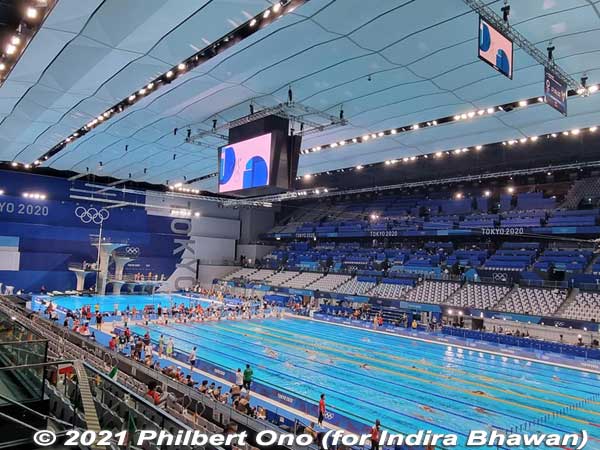
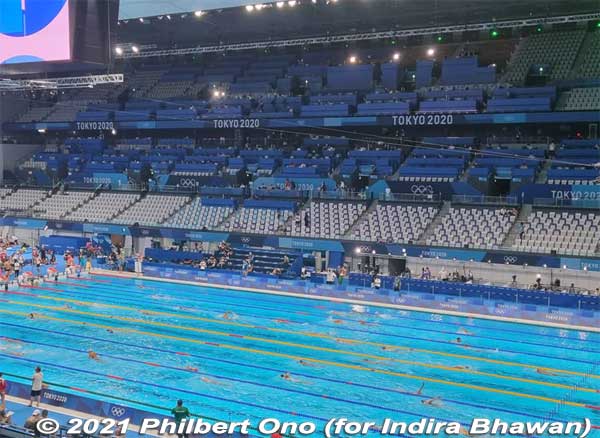
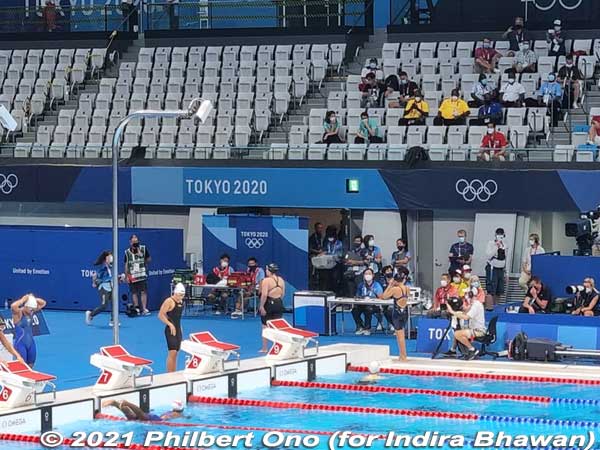
Tokyo Aquatics Centre (TAC) was in Indigo blue. Photos show Olympic competitive swimming on July 26, 2021. Photos by Indira Bhawan.
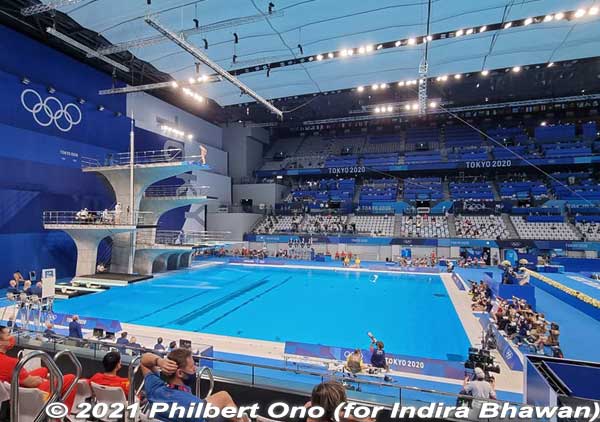
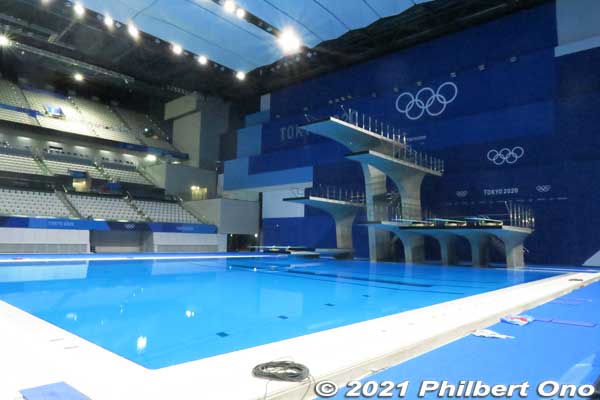
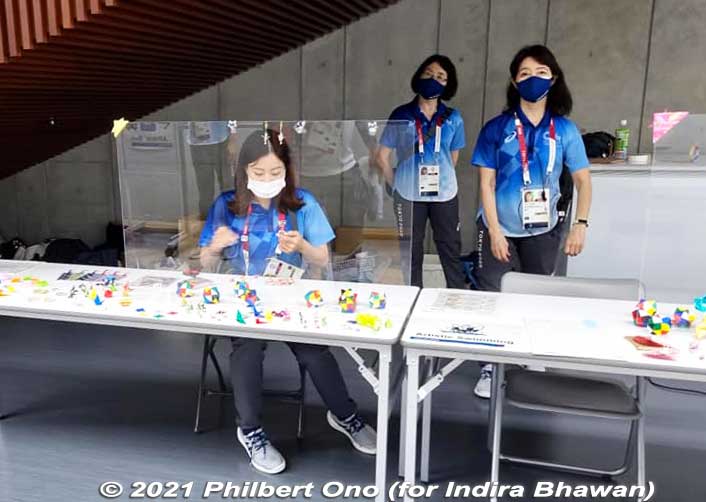
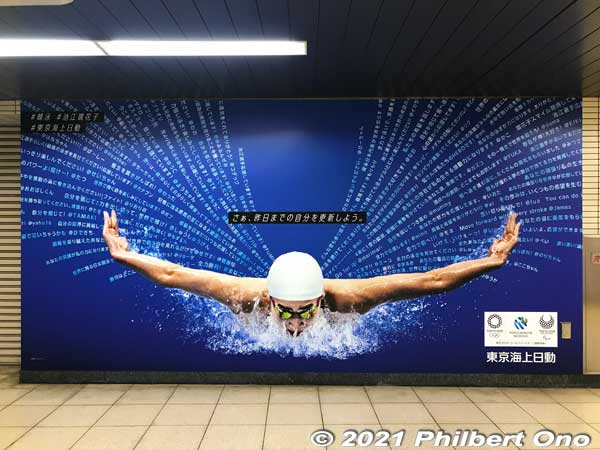
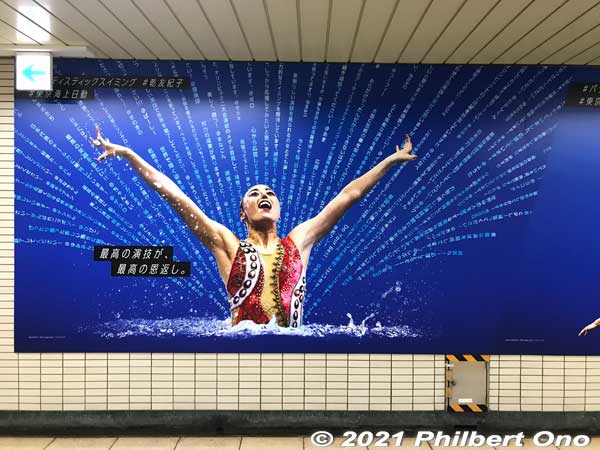
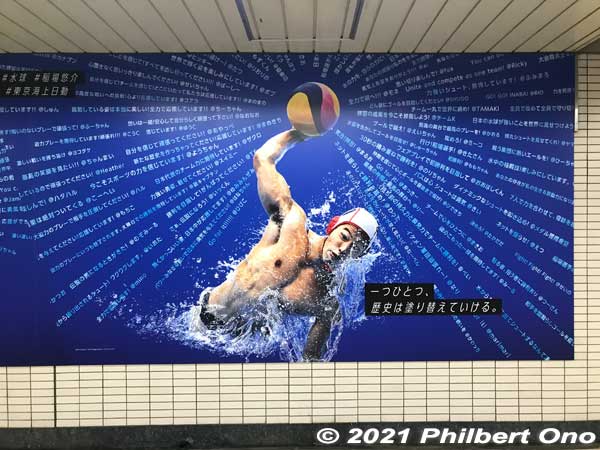
Large aquatics PR posters in Tatsumi Station (Yurakucho Line) near the aquatics venues. Swimming, artistic swimming (Inui Yukiko), and water polo.
Tokyo International Forum (TIF) (東京国際フォーラム) – Weightlifting, Paralympic Powerlifting

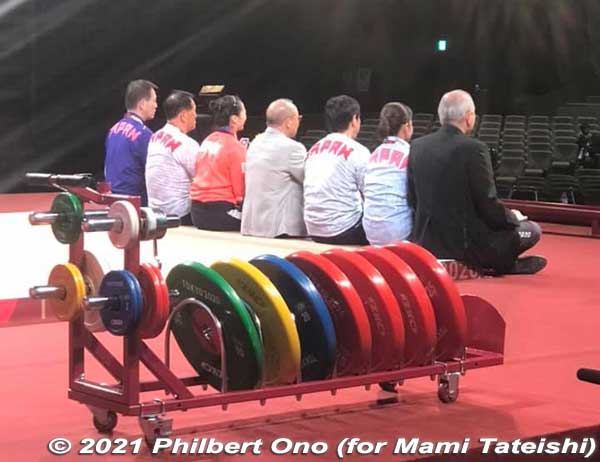
Tokyo Metropolitan Gymnasium (TGY) (東京体育館) – Olympic/Paralympic Table Tennis

The original Tokyo Metropolitan Gymnasium was built here in 1954 and used for gymnastics and water polo during the 1964 Tokyo Olympics. In 1990, the aging gymnasium was rebuilt and redesigned by the same architect who designed Makuhari Messe in Chiba (taekwondo). It also saw major renovations for Tokyo 2020. Capacity was 7,000 for Olympics and 6,500 for Paralympics.
The greatest thing about Tokyo Metropolitan Gymnasium (Tokyo Taiikukan) is that it’s right in front of JR Sendagaya Station and Kokuritsu Kyogijo subway station. It’s also right next to the Olympic Stadium.
Tokyo Stadium (TOS) (東京スタジアム) – Football, Modern Pentathlon

Tsurigasaki Surfing Beach (TSB) (釣ヶ崎海岸サーフィンビーチ) – Surfing
・Opened: 1950s ・Location: Near Kazusa-Ichinomiya Station. ・Map ・Status: Open to the public.
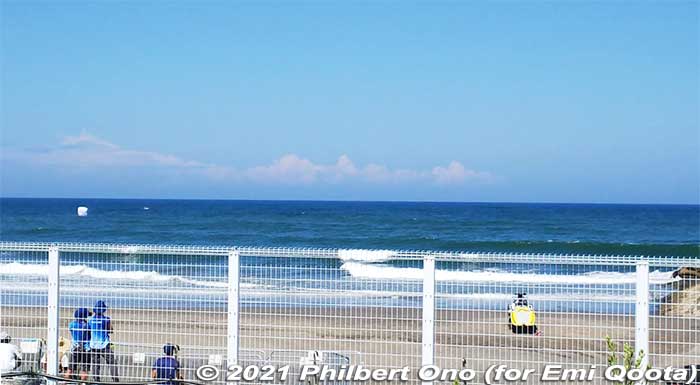
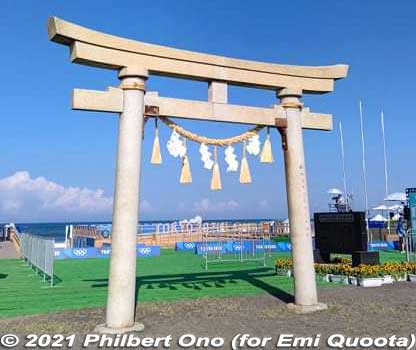
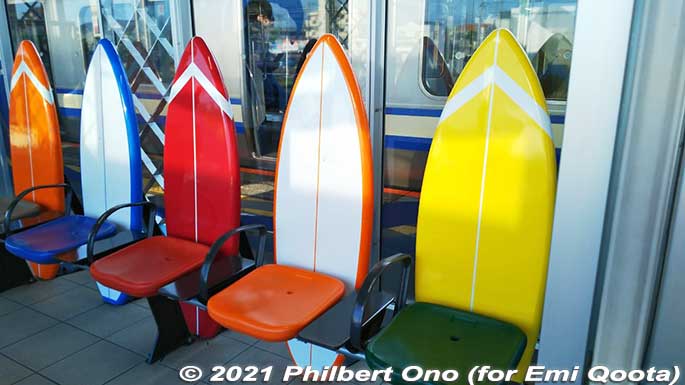
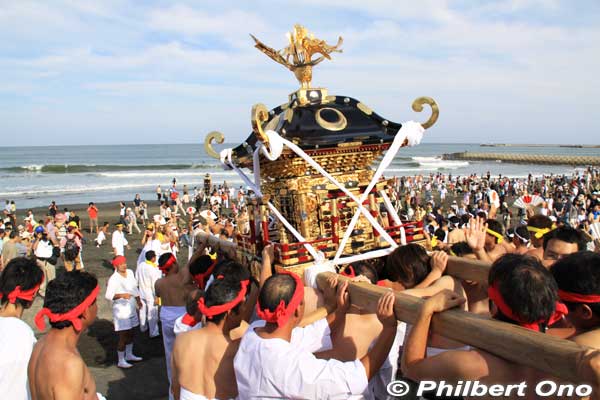


Tsurigasaki Surfing Beach is the Olympics’ first venue for surfing, a new Olympic sport. Where Carissa Moore from Hawaiʻi won the women’s gold medal. Among local surfers, the beach’s local nickname is “Shidashita” (志田下) named after a beach rest house operated by the Shida family during the summer from 1958 to 1985. Popular spot for surfing with good waves almost year-round.
As indicated by the torii, Tsurigasaki Surfing Beach is a sacred site for nearby Tamasaki Shrine dedicated to the goddess Tamayori-hime (daughter of the sea-dragon god). Tsurigasaki was where the goddess first came ashore. She is celebrated every year with a festival in September.
A: Tsurigasaki Surfing Beach (TSB) seems to have a blue ocean after all, when it’s sunny (not the usual murky green/brown).
B: Tsurigasaki’s landmark torii belongs to nearby Tamasaki Shrine.
C: The nearest train station (Kazusa-Ichinomiya Station) has surfboard seats in the waiting room on the train platform. (Photos above by Emi Quoota.)
D: Once a year, divine relatives of goddess Tamayori-hime gather here. This gathering is reenacted by the Kazusa Junisha Matsuri Festival (上総十二社祭り) held annually on September 13 on Tsurigasaki Beach. Several god-occupied mikoshi portable shrines gather at Tsurigasaki Beach and go into the water. Festival is nicknamed “Hadaka Matsuri” (nude festival) because of the people’s skimpy clothing. (Nobody is really nude.)
E: Each portable shrine is carried into the ocean. Lots of jostling, shouting, and the portable shrine is even thrown into the air (and caught).
F: After leaving the ocean, the portable shrines pass through the torii. Sadly, the festival was canceled in 2021.
When the Games were postponed, Tsurigasaki Surfing Beach already had 70% of Olympics-related construction completed. They included prefab buildings for surfers, staff, and the press. Since prefab structures might not endure the typhoon season, a few were boarded up. Further construction (three months worth) were suspended until they restarted in 2021.
Ichinomiya is rural and normally teeming with surfers patronizing surf shops and restaurants. During April and May 2020 when people were urged to stay home, the local economy was hit hard with beaches closed to surfers. The postponement was also psychologically hard on the local people after the town had been preparing for surfing to be held for the first time at an Olympics.
Yokohama Baseball Stadium (YBS) (横浜スタジアム) – Baseball, softball
Yoyogi National Stadium (YNS) (国立代々木競技場) – Handball, Paralympic Badminton, Wheelchair Rugby
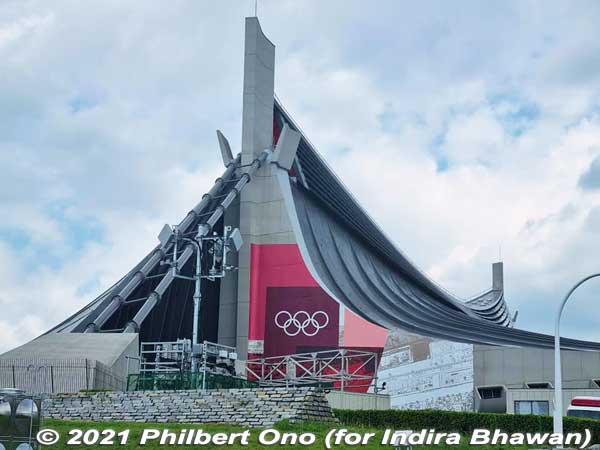
Along with the Budokan (posted earlier), the Yoyogi National Stadium (YNS) is another iconic venue for its striking design. Designed by Kenzo Tange, it’s one of Japan’s most famous modern buildings. Legacy venue originally built for swimming and diving (plus basketball in the smaller gym) at the 1964 Tokyo Olympics.
The building looks like it’s in motion, twirling like a rhythmic gymnast or ballerina. Famous for the suspension roof using the same principle as suspension bridges. In August 2021, the building became a National Important Cultural Property.
The entrance plaza originally had all cobblestones, but to improve accessbility, there’s now a smooth stone path through the cobblestones for wheelchairs. There’s also a ramp for wheelchairs.
In 2010-2011, the roof was repainted for the first time, so it doesn’t look old. In 2017-2018, the building was retrofitted for earthquake resistance. This building is also Japan’s first to use hydraulic dampers to reduce the roof/ceiling shaking from earthquakes and typhoons.
Convenient location, near JR Harajuku Station and Meiji-jingumae subway station. It’s also near Harajuku (Takeshita-dori), Omotesando, Meiji Shrine, and Yoyogi Park. Short train ride from places like Shinjuku and Shibuya.


Photos show an Olympic men’s handball match between Sweden and Portugal. Inside, the suspension roof enables an interior with no pillars obstructing the spectators’ view. Capacity for Tokyo 2020 is about 10,200.
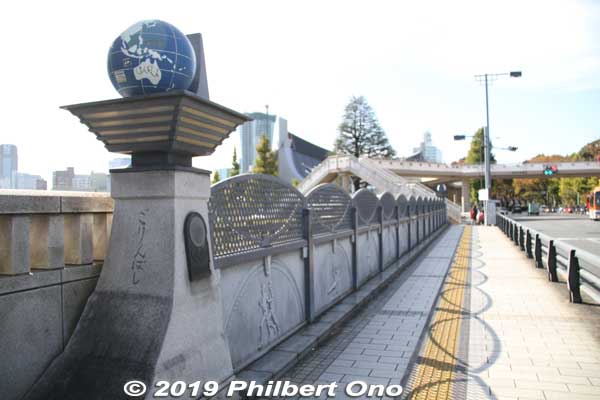

From Harajuku Station on the way to Yoyogi National Gymnasium, there’s this “Olympic Bridge” (Gorin-bashi 五輪橋). The bridge pillar on both ends of the bridge has a blue globe on top. This bridge was redesigned this way in 1993, not 1964. The Olympic Bridge wall has relief sculptures of Olympic sports.
Yumenoshima Park Archery Field (YAF) (夢の島公園アーチェリー場) – Olympic/Paralympic Archery
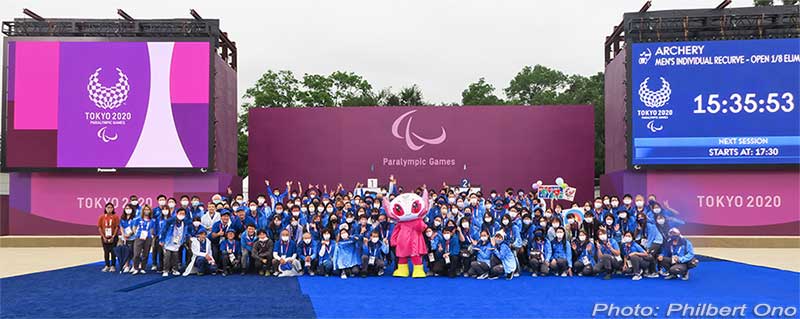
Yumenoshima is one of Tokyo’s many artificial islands built with landfill. “Yumenoshima” can mean, “Island of Dreams Come True.” There were two archery fields: Ranking Round Field (aka Training Field) (permanent venue) and the beautiful Final Field (temporary venue) both in Wisteria Purple. Most of the competition was held on the Final Field. Photo shows the Final Field with staff and volunteers posing with visiting Paralympic mascot Someity in rain gear.

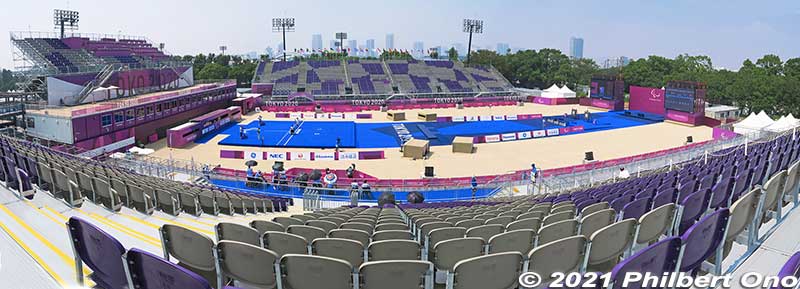

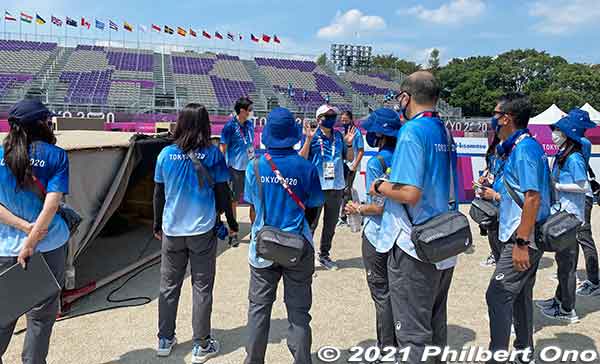
Left: Some of the Press Operations (PRS) volunteers undergo first-day training at the Venue Media Centre (VMC), followed by a tour of the venue (right). Spectator seats in the background (West Stand) sport a purple checkered pattern reminiscent of the official emblem’s ichimatsu moyo.
Training was conducted by the Venue Media Manager (VMM) and Venue Photo Manager (VPM). Some volunteers and staff were carryovers from Olympic archery to make Paralympic operations smoother.
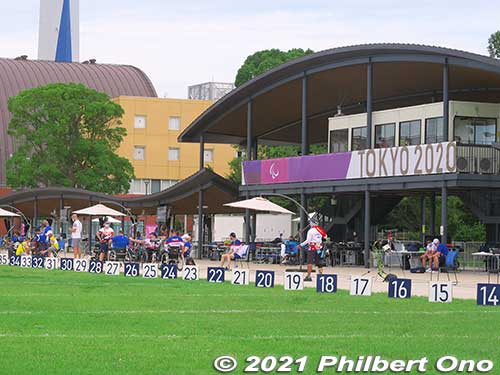

B: Italians aim for the target on the Ranking Field.
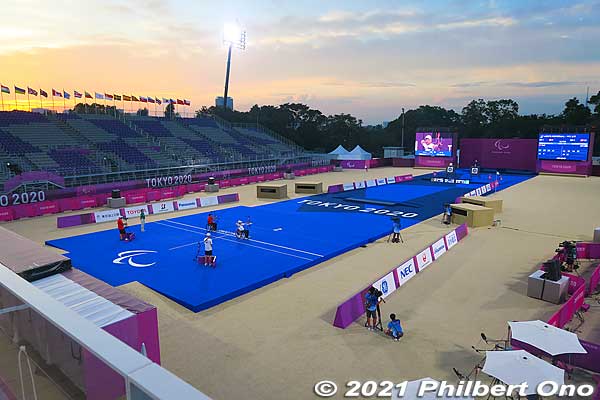
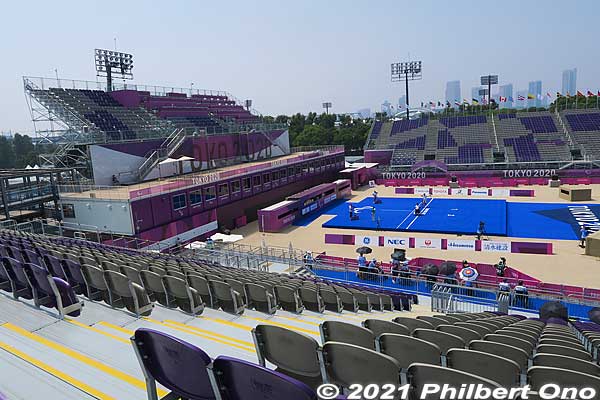

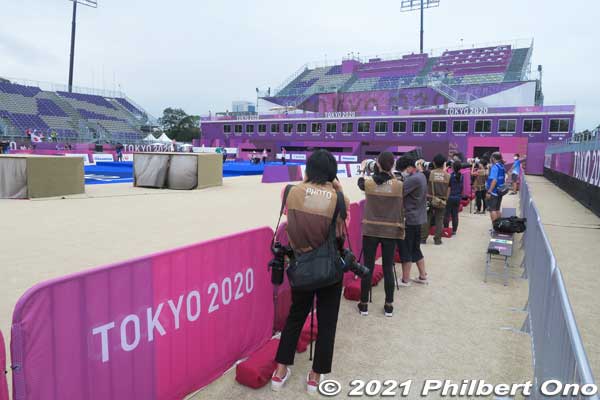
A: South Stand on the left, as seen from the East Stand. Athletes competed in front of the South Stand.
B: Yumenoshima Final Field as seen from the South Stand. Targets straight ahead. The brown boxes on both sides are hides for camera operators and photographers. They were very hot inside under the sun.
C: At the Final Field, Japanese press photographers focus on Japanese archers. They also had the option to use the box-like hides seen on the left.
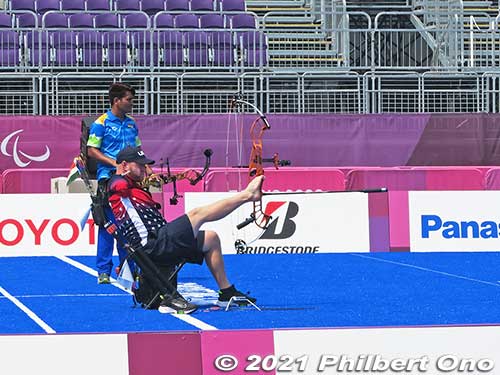

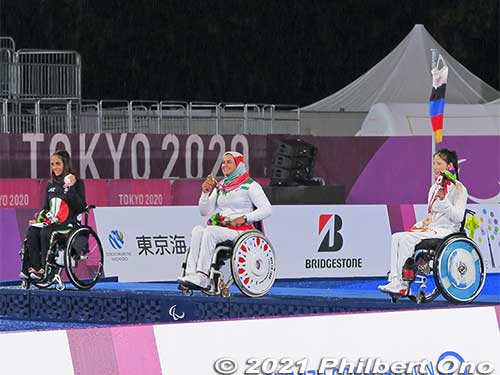
G: Matthew Stutzman aka “Armless Archer” in Men’s Individual Compound – Open 1/16 Elimination on Aug. 28, 2021.
H: Japanese Para archer Okazaki Aiko in Women’s Individual – W1 Quarterfinal on Sept. 1, 2021. 岡崎 愛子
I: Women’s Individual Recurve – Open medalists on the Victory Ceremony medals podium.
L-R: Silver medalist PETRILLI Vincenza from Italy, Gold medalist NEMATI Zahra from Iran (her third consecutive gold medal), and Bronze medalist WU Chunyan from China on a rainy Sept. 2, 2021.
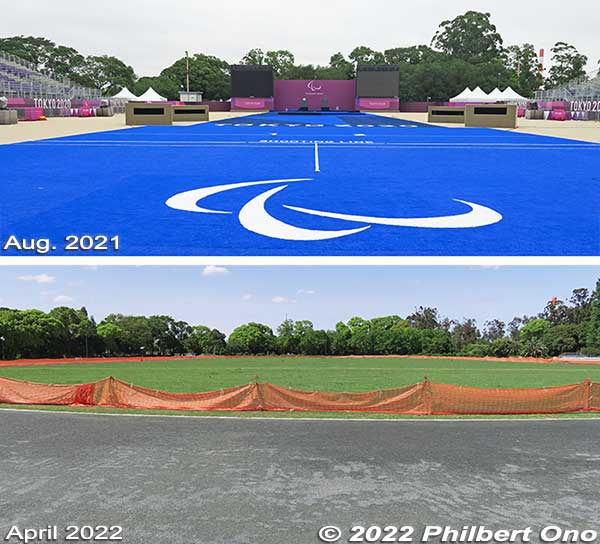
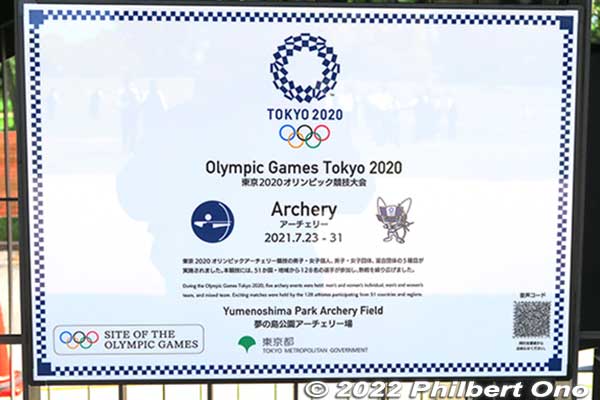
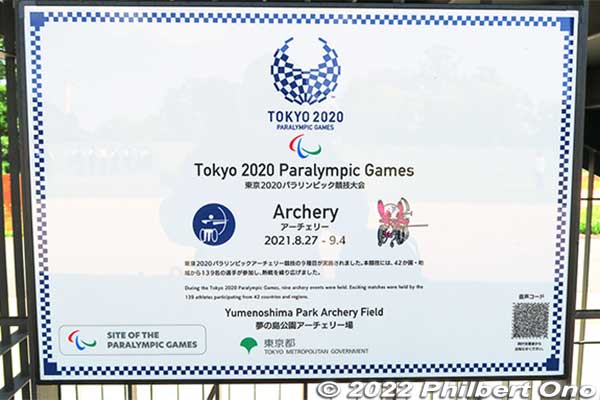
Flower Lane Project (フラワーレーンプロジェクト)
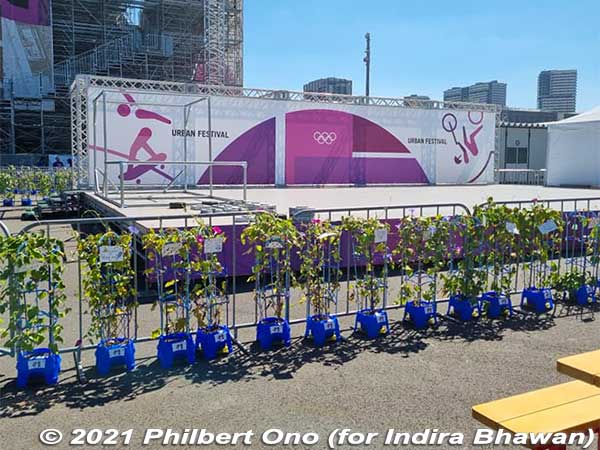

Flower Lane Project had all the Olympic venues decorated with potted morning glories grown by local school children. They were placed where athletes would pass by. Each morning glory plant had an encouraging message for athletes handwritten by the children (right photo).
About 33,000 school children at 300–400 local elementary schools participated in the Flower Lane Project to grow and present 40,000 potted morning glories. Turns out that the flowers saved some money by being used as fences to direct crowds. It was another way to get as many people as possible involved in the Games.
Volunteers and staff at a few venues like Saitama Super Arena and Sea Forest Waterway even wrote reply messages and attached them to the potted flowers which were returned to the schools after the Olympics.
Signs of Support
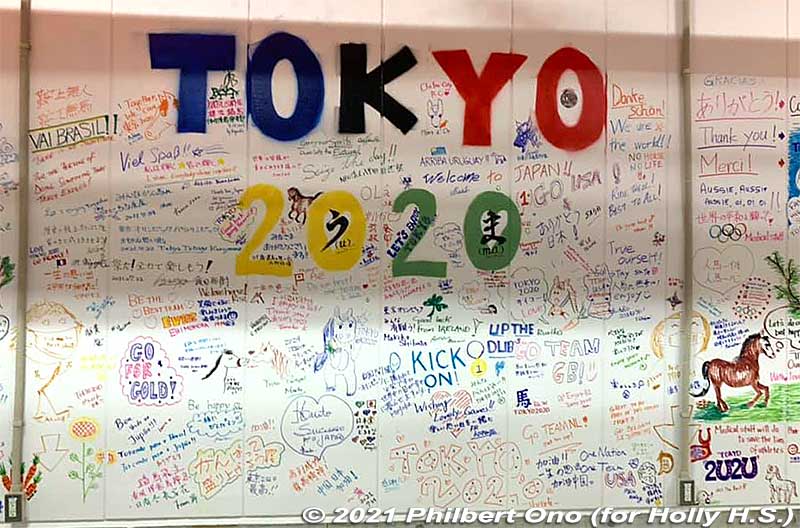

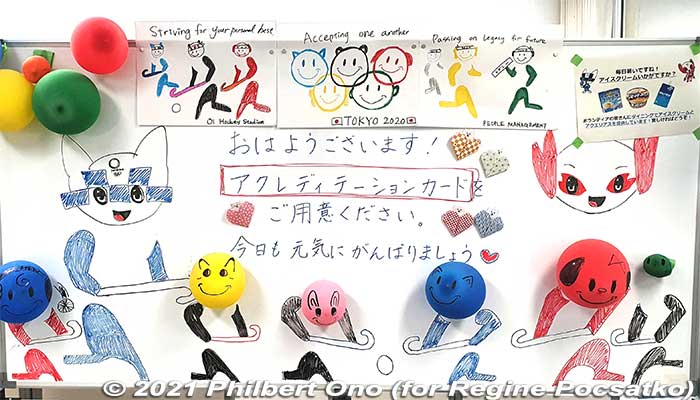
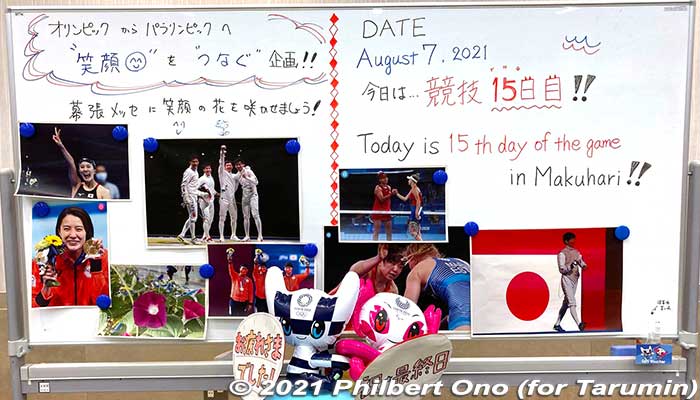
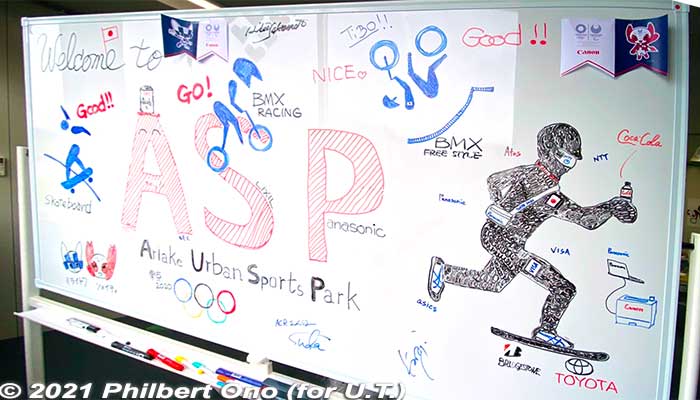
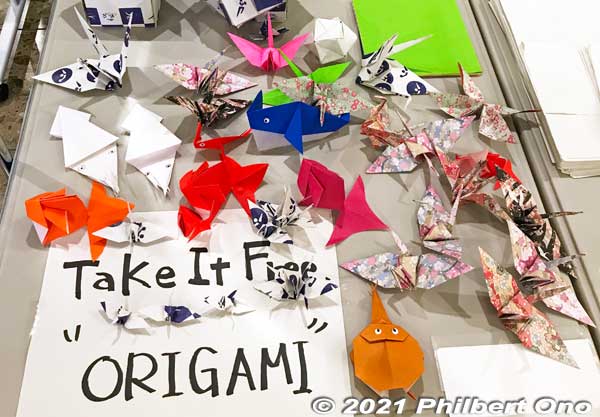
All venues had a white bulletin board for Field Cast Games volunteers. They were quite creative.
A: Message board at Equestrian Park.
B: Board at Tatsumi Water Polo Centre‘s Field Cast Rest Area had drawings of the Water Polo Centre and Aquatics Centre. It urged people to drink water to prevent heat illness.
C: Welcome board at Oi Hockey Stadium’s volunteer check-in counter. “Have your accreditation card ready.”
D: Board at Makuhari Messe Hall A mentioning Japanese medalists.
E: Board at Ariake Urban Sports Park with sponsors labeled on a skateboarder.
F: Origami cranes were also common at venues. Sometimes volunteers had nothing to do, so they made origami. This is the Help Desk at Tatsumi Water Polo Centre.
Tokyo Big Sight (東京ビッグサイト) – International Broadcast Centre (IBC), Media Press Centre (MPC)
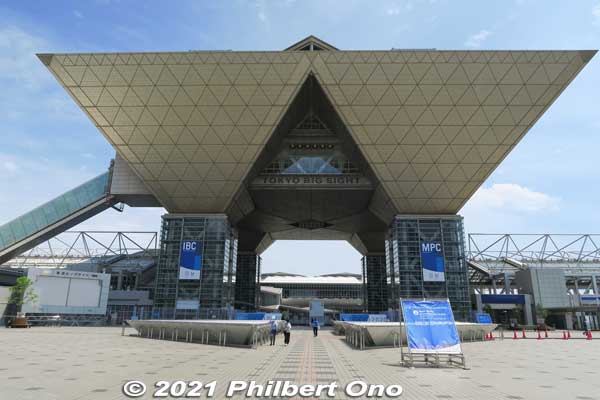
Normally used for large trade shows, Tokyo Big Sight was Tokyo 2020’s media headquarters for TV broadcasters, accredited journalists, and press photographers. It housed the International Broadcast Centre (IBC) and Media Press Centre (MPC).
The International Broadcast Centre (IBC) was in the East Halls, and Media Press Centre (MPC) in the West Halls. The International Broadcast Centre had TV studios and interview spaces mainly occupied by OBS (Olympic Broadcasting Services) which filmed all the events.
Media Press Centre had large workrooms for journalists and photographers (capacity 700), private offices for media companies, and press conference rooms. The MPC was managed by Press Operations (PRS) which also had an office on site. Since the number of media members was significantly cut back, Tokyo Big Sight was not as busy as originally expected.
At the MPC, the IOC held a total of 24 press conferences during the Olympics, and the IPC held 18 press conferences during the Paralympics. They covered topics such as the summer heat, coronavirus, fan engagement, volunteers, athletes’ mental health, and accessibility.
Tokyo Big Sight was not open to the public. Open only to accredited media members, athletes requested for interviews or press conferences, and supporting staff/volunteers. When Tokyo 2020 was postponed, getting Tokyo Big Sight for 2021 was a major sticking point since it had already booked 100 trade shows from Oct. 2020 to autumn 2021.
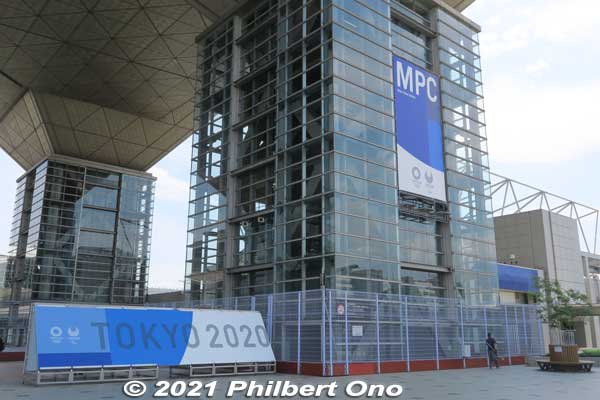
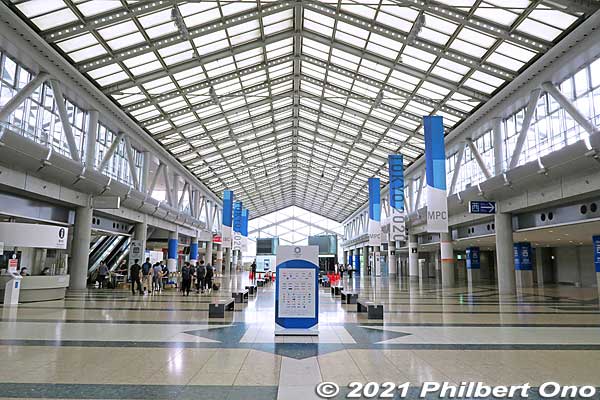

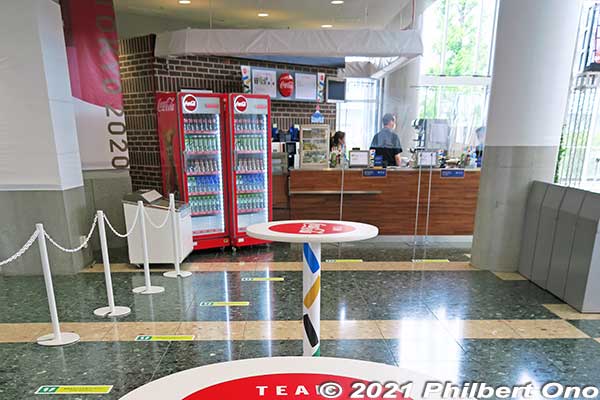

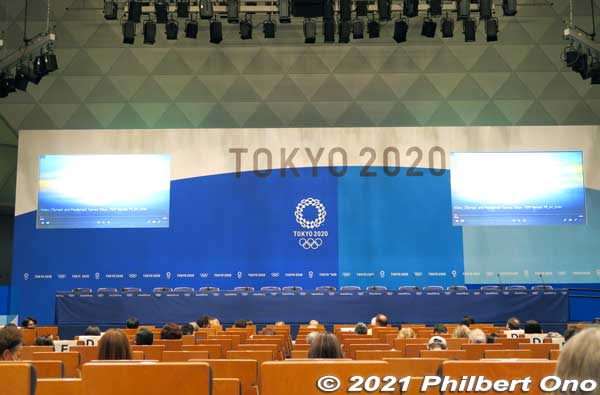
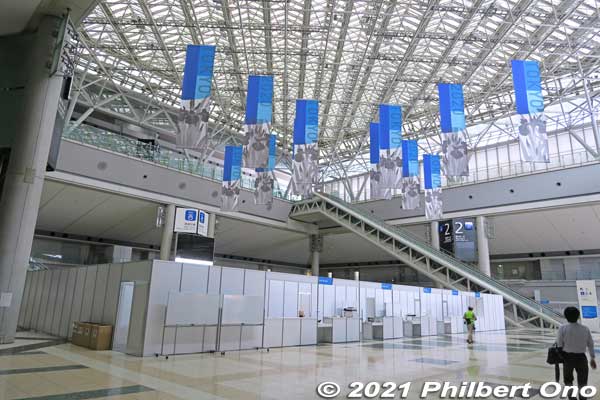
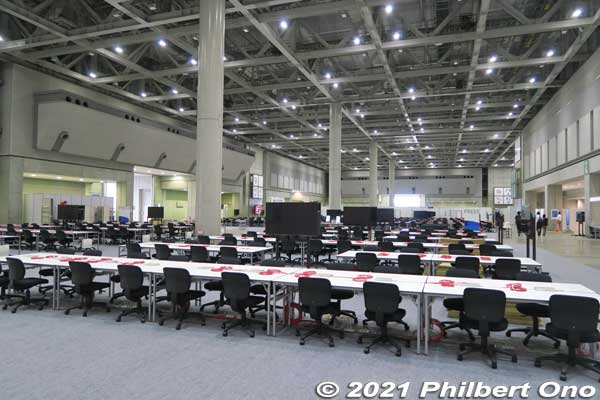

A: MPC signage on the Conference Tower.
B: Main entrance hall with Tokyo 2020 banners in indigo. Named “High Street” during the Games like a town’s main street with a general store and eateries. The East Halls (IBC) are toward the left, and West Halls (MPC) on the right.
C: Corridor to IBC. Storefront of the small Tokyo 2020 Official store can also be seen.
D: Concession stand by Coca-Cola on High Street.
E: Field Cast Dining and Rest Area. Very large room.
F: Main Press Conference Room (Conference Tower 7th floor, capacity 700, simultaneous interpreting provided).
G: Main Press Centre Atrium. Help Desk was here.
H: Press/photo workroom for 700. Equipped with Internet cables and power outlets. Canon and Nikon also provided equipment rentals and repairs.
I: Photo lockers available for free in the Photo workroom. Same type of lockers also provided at all the Venue Media Centres at each venue.
Venue Media Centre (VMC)
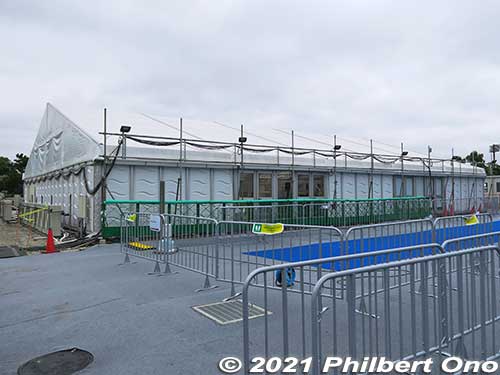
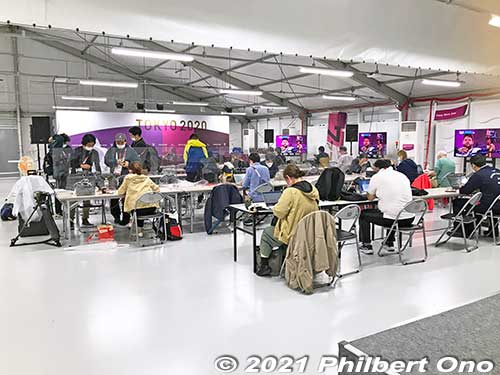


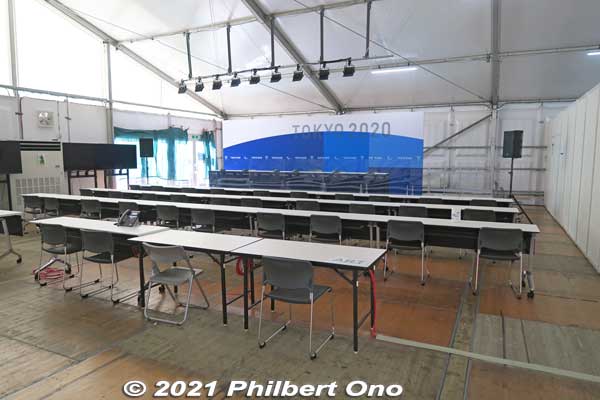
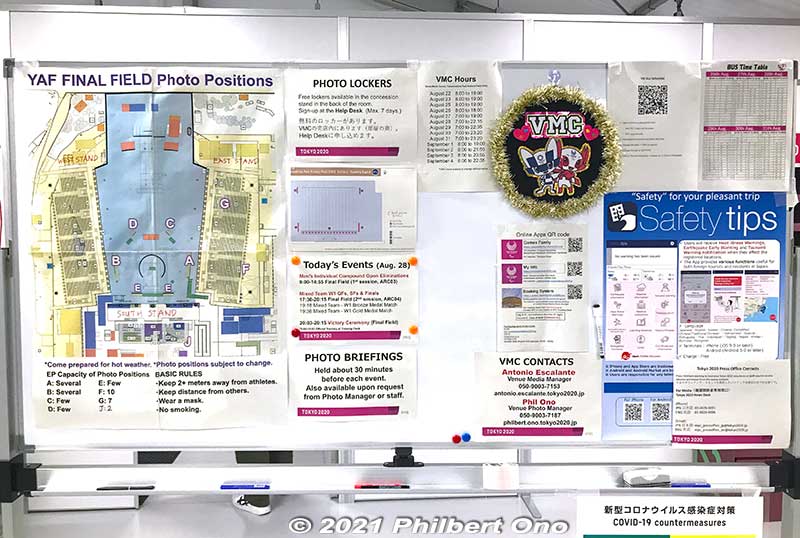
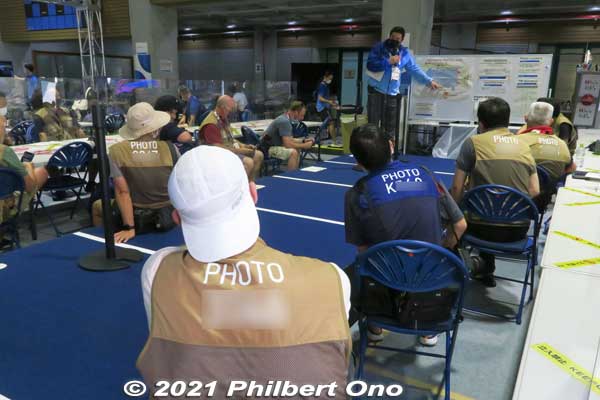
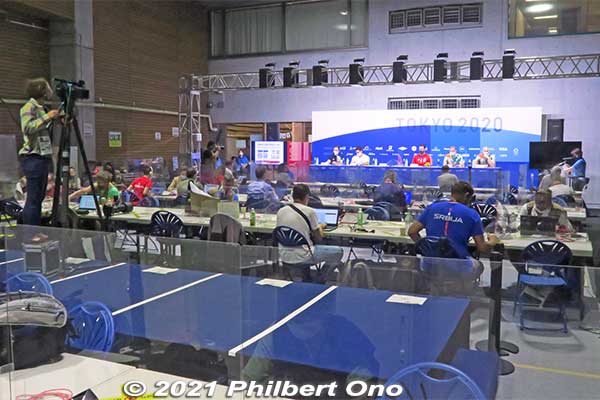
Since each venue has accredited journalists and press photographers covering the events, each venue has a comfortable, air-conditioned facility called the Venue Media Centre (VMC) where media members can work or rest while at the venue. The VMC has a large work room with tables equipped with Internet LAN cables and power outlets for journalists and photographers to file their stories or photos. At Tokyo 2020, plexiglass and sanitizing wipes were also provided.
The VMC includes a press conference room which may be in the work room or in a separate room. For photographers, a daily photo briefing is also held in the VMC. Whatever assistance photographers and journalists need, the VMC staff is here to help. The VMC is like a smaller version of the MPC (Media Press Centre) at Tokyo Big Sight.
The VMC also has a Help Desk to assist the media with essential information (competition schedules, transport schedules and directions, etc.) and a concession stand (operated by Games sponsor Coca-Cola) providing bottled water, hot coffee, bananas, and simple sandwiches for free to the media. (More substantial light meals and cold soft drinks available for sale.) Free lockers were also provided.
The VMC is run by the Press Operations (PRS) department staffed by the Venue Media Manager (VMM), Venue Photo Manager (VPM), supervisors, and Games volunteers. Busier venues may also have Deputy Managers.
Photos:
A: Exterior of the Venue Media Centre at the Yumenoshima archery venue. Temporary “tent construction” building commonly used at venues. With strong winds, the tent covering would ripple and make noise. If there was a typhoon, it would have to be dismantled. Luckily, no typhoons struck Tokyo 2020. In the foreground is the Mixed Zone where the media can conduct short interviews with athletes.
B: Media people working inside the VMC which can also be a press conference room. (Photo shows only half of the VMC.)
C: VMC workroom at Tokyo Aquatics Centre. (Still being readied.)
D: VMC workroom at Ariake Tennis Park.
E: Press Conference Room at Ariake Tennis Park.
F: Inside the VMC, notice board for photographers. Venue map of photo positions, media bus schedule, etc.
G: Photo briefing by the Venue Photo Manager in the VMC for photographers. The basic rules for shooting are explained. All accredited photographers must wear an official photo vest to enter the venue. Each vest has an ID number. At Tokyo 2020, a navy blue vest was worn by photographers from the biggest media agencies. They get better shooting positions. Photographers wearing a khaki vest are general photographers.
H: Press conference in the VMC at the water polo venue. In foreground is the platform for TV/video cameras. Press conferences are managed and emceed by the Venue Media Manager.
AUGUST 2021

August 2, 2021: Yoyogi National Stadium is designated as a National Important Cultural Property. The distinctive building was designed by Tange Kenzo for the 1964 Tokyo Olympics as the swimming venue. The building looks like it’s in motion, twirling like a rhythmic gymnast or ballerina. Famous for the suspension roof using the same principle as suspension bridges.
The entrance plaza originally had all cobblestones, but to improve accessbility, there’s now a smooth stone path through the cobblestones for wheelchairs. In 2017-2018, the building was retrofitted for earthquake resistance. The building is also Japan’s first to use hydraulic dampers to reduce the roof/ceiling shaking from earthquakes and typhoons.
August 5, 2021: Japan and Tokyo see record numbers of COVID-19 cases, reaching as high as 5,042 cases this day. With the Olympics having no spectators, TOCOG denies the Games as the cause of the surge.
🍀August 5, 2021: Field Cast Office sends an email to volunteers saying that volunteers are not allowed to spectate when off duty. (This policy changes for the Paralympics where volunteers were allowed to spectate in the venue’s designated area.)
Japan reaps a record 58 Olympic medals, including 27 gold medals, its most ever. Followed by 14 silver and 17 bronze medals. Japan’s medal count is Tokyo 2020’s third highest, only behind the US and China.


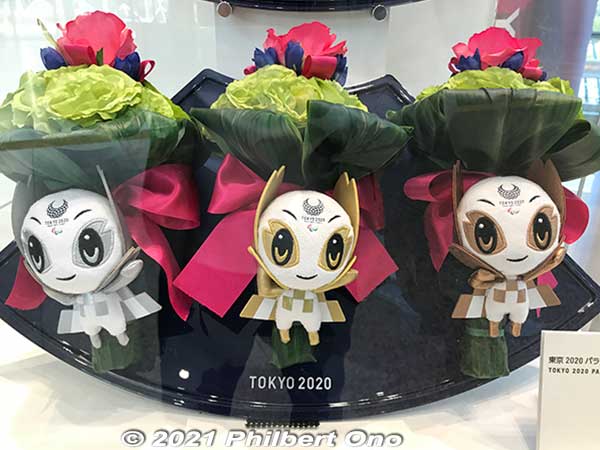
Tokyo 2020 Victory Bouquets given to medalists have a special edition of the official mascots in gold (center), silver, or bronze and fresh flowers from Fukushima, Miyagi, and Iwate Prefectures where the giant earthquake and tsunami hit the coastal areas in March 2011. Green aspidistras (dark green) from Tokyo are also included in all the bouquets. *Flowers from Fukushima are perfectly safe and have no radiation.
Left: Olympic Victory Bouquets have eustomas (light green) from Fukushima, sunflowers from Miyagi, gentians (dark blue) from Iwate, and Solomon’s seals from Fukushima.
Right: Paralympic Victory Bouquets have eustomas from Fukushima, red roses from Miyagi, and gentians from Iwate.
🔴 August 8, 2021: Tokyo 2020 Olympics Closing Ceremony is held at the Olympic Stadium with 4,500 athletes and no spectators. To cut costs and simplify the ceremony, the number of performers is cut to one-fourth the original number, from 800 to 200. The NHK television audience for the live broadcast of the Closing Ceremony peaks at 46.7 percent of viewers in Tokyo.
🍀Japanese media publishes many articles praising Olympic athletes and volunteers. The pre-Games negativity in the mass media disappears as if it were nothing. No apologies, no congratulations, and no compliments from the prominent Japanese CEOs, doctors, politicians, etc., who spread negativity and panic before the Games.
With spectators banned in the Tokyo area, Tokyo 2020 Olympics saw a total of only 43,000 spectators at venues allowing spectators in Miyagi, Ibaraki, and Shizuoka Prefectures.

August 9, 2021: IOC President Thomas Bach, with a security detail, is spotted taking a stroll in Tokyo’s Ginza district despite coronavirus restrictions imposed on athletes and officials.
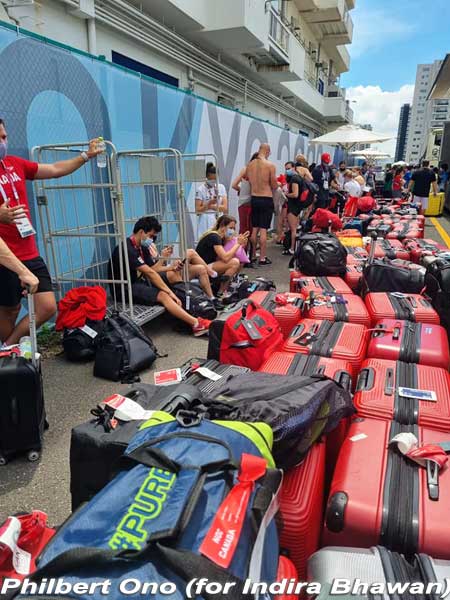
August 10, 2021: TMG announces that the Tokyo Paralympic torch relay is to be taken off Tokyo’s public roads during August 20–24. The planned 700 torch bearers will instead gather at a celebration venue and pass on the flame in a “torch kiss” event.
August 11, 2021: Olympic Village in Harumi closes.
August 11, 2021: After serving as one of the most photographed edifices and background scenes of Tokyo 2020, the giant Olympic rings (15 meters high) on a floating barge at Odaiba Marine Park are towed away to Yokohama to be scrapped for recycling.
August 12–24, 2021: The Tokyo Paralympic torch relay is held with a total of 1,070 torch bearers. Lighting ceremony is held in all 47 prefectures, and a torch relay or lighting ceremony is held in the four prefectures (Shizuoka, Chiba, Saitama, Tokyo) having Paralympic venues.
🔴 August 16, 2021: Public opinion poll by Kyodo News shows that 62.9 percent of respondents thought it was good to hold the Olympics and 30.8 percent thought it was not good.
🔴 August 16, 2021: After a meeting between the five organizers, they sadly announce that the Tokyo Paralympics would be held without spectators due to the spike in Covid infections in Japan. No one is surprised by the announcement.
The only exception would be students who would be allowed to spectate at Paralympic venues as part of a government-backed educational program. Tokyo Governor Koike acknowledged the educational value for school kids to watch Paralympic athletes. It still makes many schools and parents anxious over the program, especially when two teachers who took students to see goalball on August 25 later tested positive for Covid.
In the end, only 15,300 students visited Paralympic venues as spectators, a lot less than originally planned.
August 19, 2021: The Japanese Olympic Committee is reported to have paid ¥200 million in legal fees for three years until fiscal 2020 for its former president Takeda Tsunekazu being investigated for bribery charges by French authorities. The JOC will keep paying Takeda’s lega fees until the investigation ends. The money is not coming from taxpayers (central government subsidies).
Back in March 2019, the JOC board passed a resolution to bear Takeda’s legal fees.
Other years:
2011 | 2012 | 2013 | 2014 | 2015 | 2016 | 2017 | 2018 | 2016 | 2017 | 2018 | 2019 | 2020 | 2021 | Olympics | Paralympics | Venues | 2022-2023



